PTSD vs. Autism
Understanding the Complex Interplay Between PTSD and Autism Spectrum Disorder
Setting the Stage for a Complex Discussion
This article explores the nuanced ways in which post-traumatic stress disorder (PTSD) and autism spectrum disorder (ASD) intersect and diverge. We dissect how trauma manifests uniquely in individuals with autism, the distinct clinical presentations of each condition, and the tailored therapeutic strategies essential for effective treatment. Our goal is to illuminate the challenges and advances in supporting individuals navigating these overlapping realms of mental health and neurodevelopment.
Defining Autism Spectrum Disorder: Core Characteristics and Impact
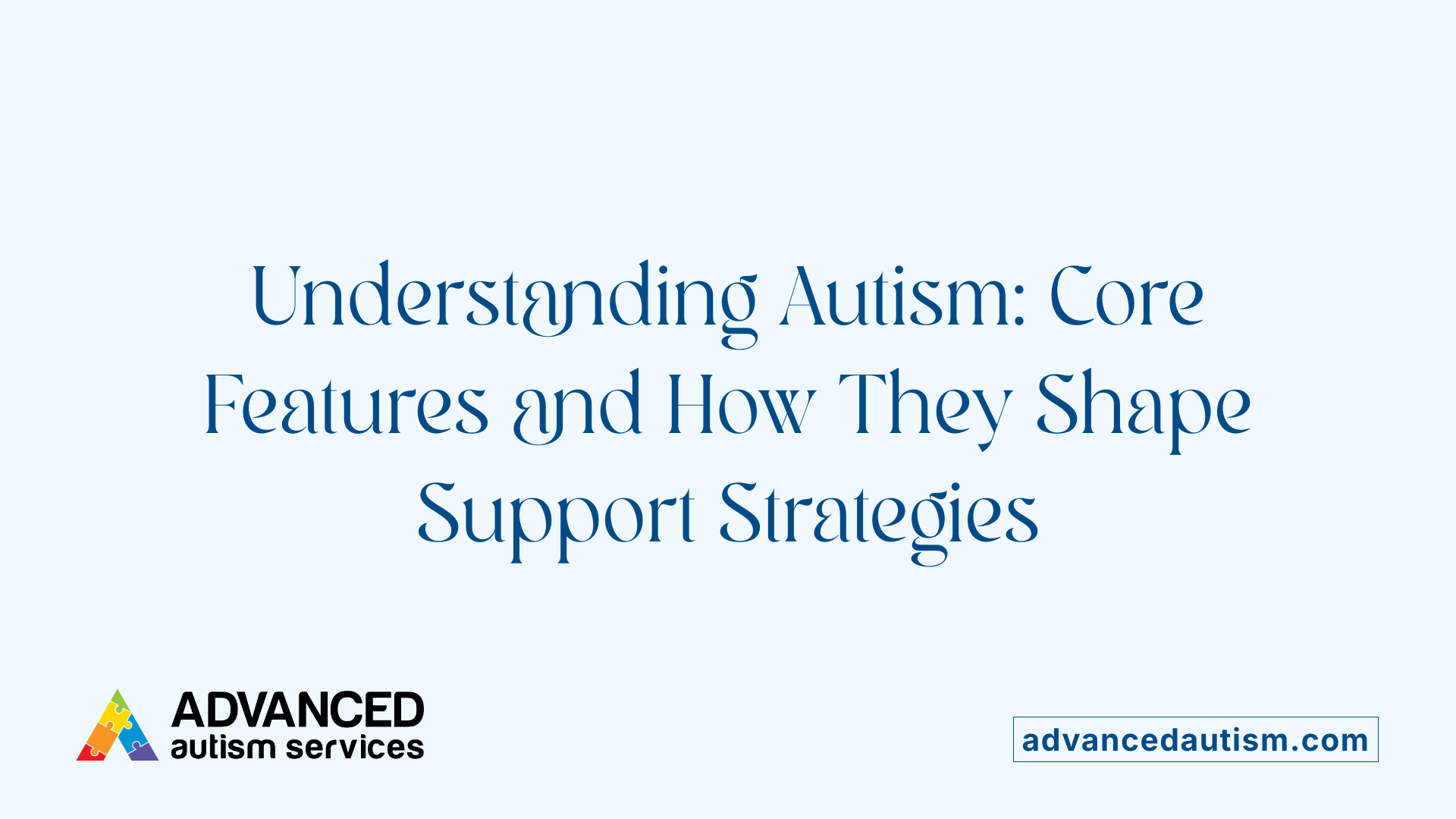
What is Autism Spectrum Disorder?
Autism spectrum disorder (ASD) is a neurodevelopmental condition that begins in early childhood and lasts throughout a person's life. It influences how individuals perceive and interact with the world around them.
How does ASD affect social communication?
People with ASD often experience differences in social communication. They may interpret social cues differently and prefer more literal, concrete language. Communication tends to focus on details and pattern recognition rather than broader social context.
What sensory processing variations occur in ASD?
Sensory processing can vary significantly in autism. Many individuals have heightened sensitivities to sensory input, which can affect how they respond to their environment. This sensory sensitivity may contribute to challenges in social situations and interactions.
What are the behavioral characteristics of ASD?
Behavioral traits in ASD typically include repetitive behaviors and restricted interests. These patterns provide predictability and comfort for individuals, and they differ from typical behavior due to their intensity or focus.
Understanding these core characteristics of ASD—social communication differences, sensory sensitivities, and behavioral traits—is essential for supporting individuals effectively, especially in contexts involving trauma and mental health.
What Is PTSD and How Does It Differ from Complex PTSD (CPTSD)?
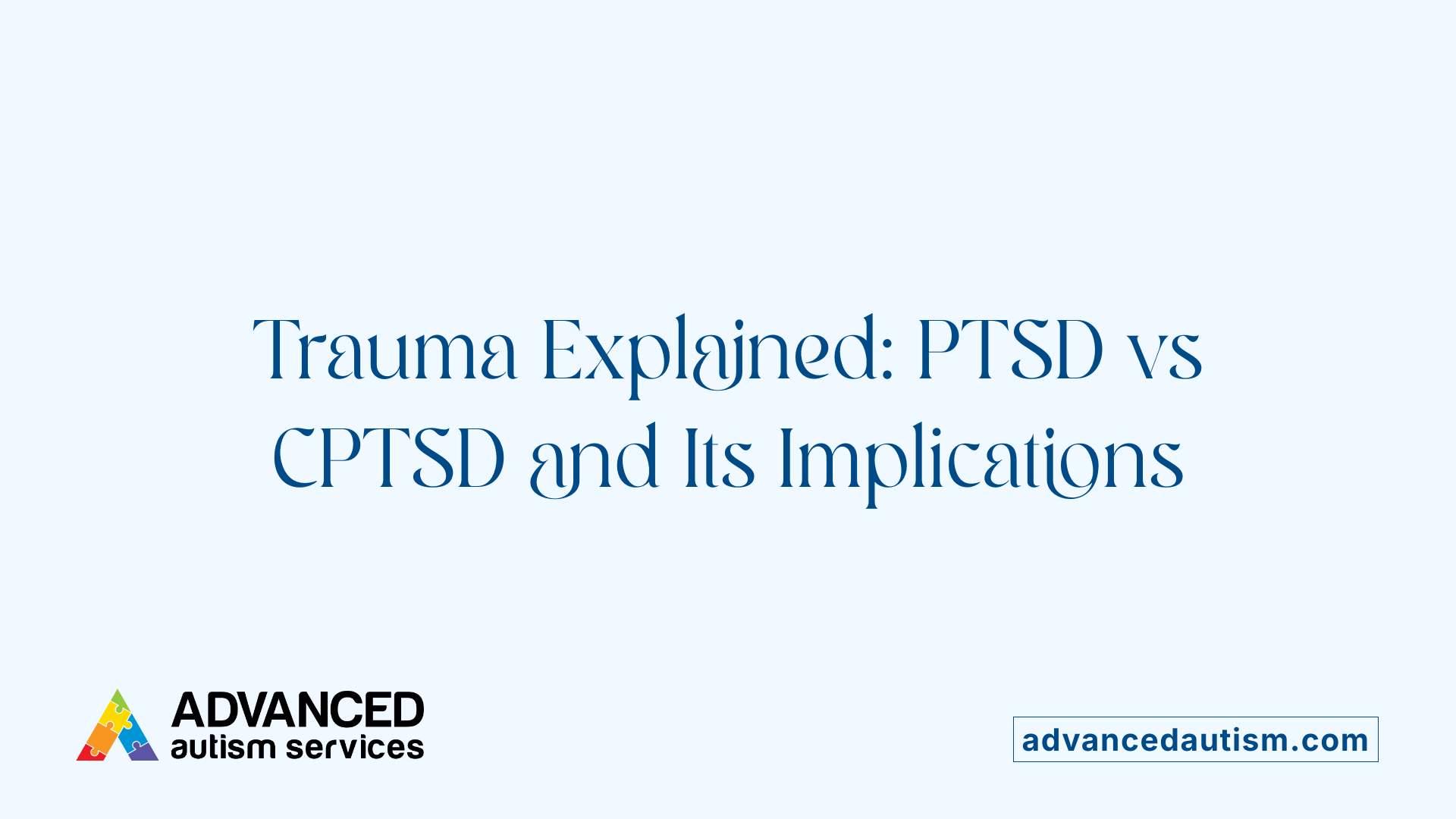
Defining PTSD
Post-Traumatic Stress Disorder (PTSD) is a mental health condition triggered by experiencing or witnessing a traumatic event. Individuals with PTSD often relive the trauma through intrusive thoughts, nightmares, and flashbacks. They may also show avoidance of reminders related to the trauma, heightened arousal, and negative changes in mood and cognition.
Symptoms of PTSD
Core symptoms include:
- Intrusive memories or flashbacks
- Avoidance of trauma reminders
- Negative mood or thoughts
- Increased arousal such as irritability or hypervigilance These symptoms can disrupt daily life and are often intense and persistent.
How CPTSD Differs
Complex PTSD (CPTSD) develops after prolonged or repeated trauma, often involving interpersonal harm. It shares PTSD symptoms but also includes additional challenges like:
- Difficulty regulating emotions
- Negative beliefs about oneself
- Trouble maintaining relationships These extra features reflect deeper disruptions in emotional and social functioning.
Emotional Dysregulation and Interpersonal Challenges
Both PTSD and CPTSD affect emotional control; however, CPTSD leads to more pronounced dysregulation. Individuals may experience intense emotional outbursts or numbness. Interpersonal difficulties, such as trusting others or feeling isolated, are more common in CPTSD, complicating recovery.
Understanding these distinctions helps tailor effective treatments, especially when conditions co-occur with other disorders like autism spectrum disorder, where social communication and sensory processing differences further influence trauma experiences.
Increased Vulnerability to Trauma Among Individuals with Autism
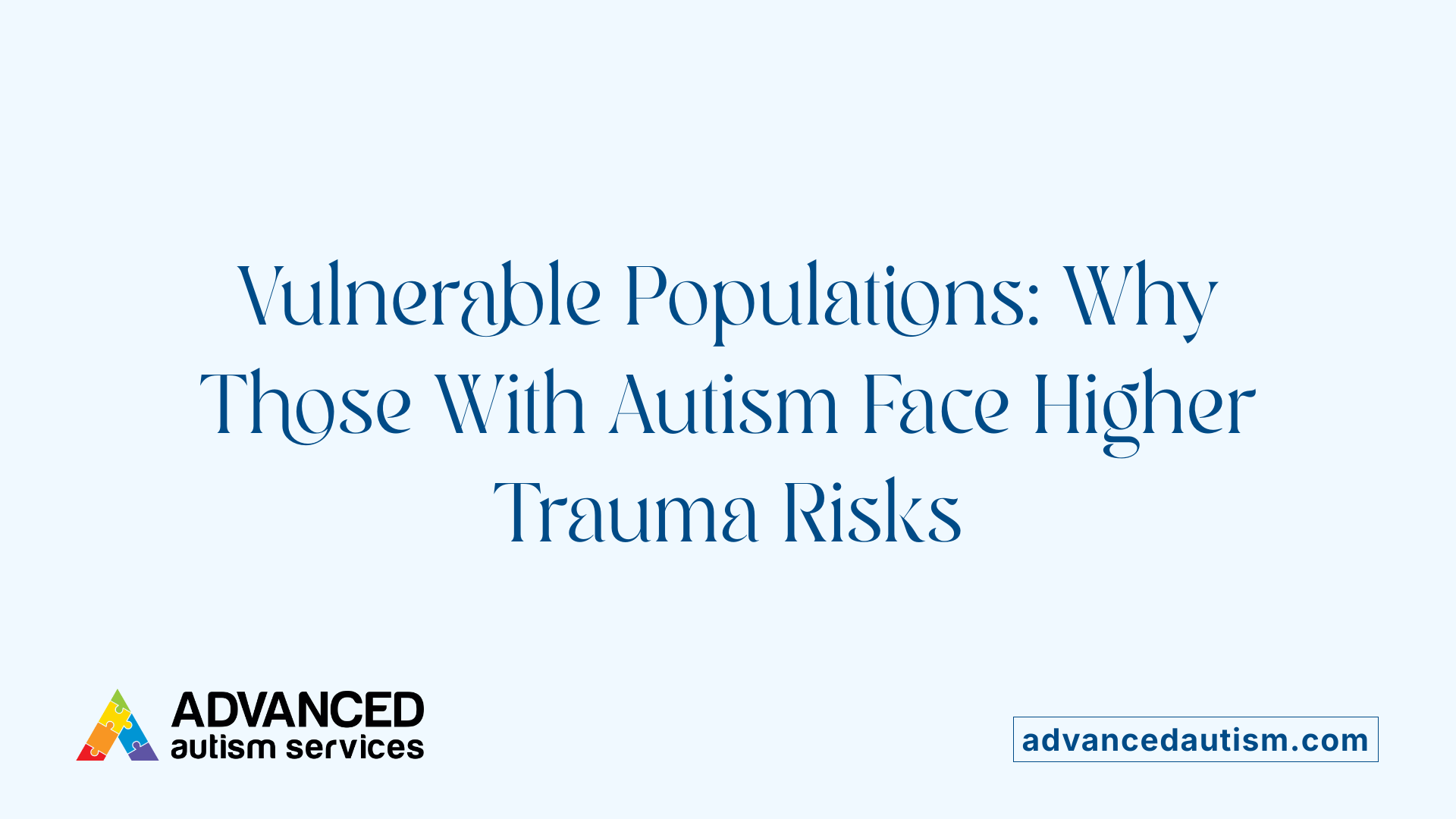
Why are individuals with autism spectrum disorder at higher risk of maltreatment and bullying?
Research shows that individuals with autism spectrum disorder (ASD) face an elevated risk of experiencing traumatic events such as maltreatment and bullying. This increased risk stems partly from core ASD characteristics that influence social interactions and vulnerability. Among these, social naiveté plays a major role. Because many autistic individuals may struggle to recognize social cues and boundaries, they can unknowingly become targets for victimization by peers or others.
How does social naiveté contribute to victimization?
Social naiveté refers to difficulties in understanding others' intentions and social rules. Autistic individuals often interpret social information literally and may have trouble predicting or responding to social dynamics. This can make them more susceptible to exploitation or mistreatment, as they might not recognize warning signs or may find it hard to assert themselves in difficult situations.
In what ways do sensory sensitivities exacerbate stress and trauma risk?
Many people with ASD experience heightened sensory sensitivities, which means they can be overwhelmed by stimuli like loud noises, bright lights, or crowded spaces. These sensory challenges can increase stress levels and contribute to feelings of vulnerability. In environments where bullying or maltreatment occur, sensory overload can reduce their ability to cope or seek help, thus intensifying the impact of traumatic experiences.
Together, these factors underline the complex reasons why individuals with autism are more vulnerable to trauma. Understanding these vulnerabilities is essential for creating supportive environments and tailoring trauma-informed care approaches.
Neurobiological Underpinnings of Trauma Sensitivity in ASD
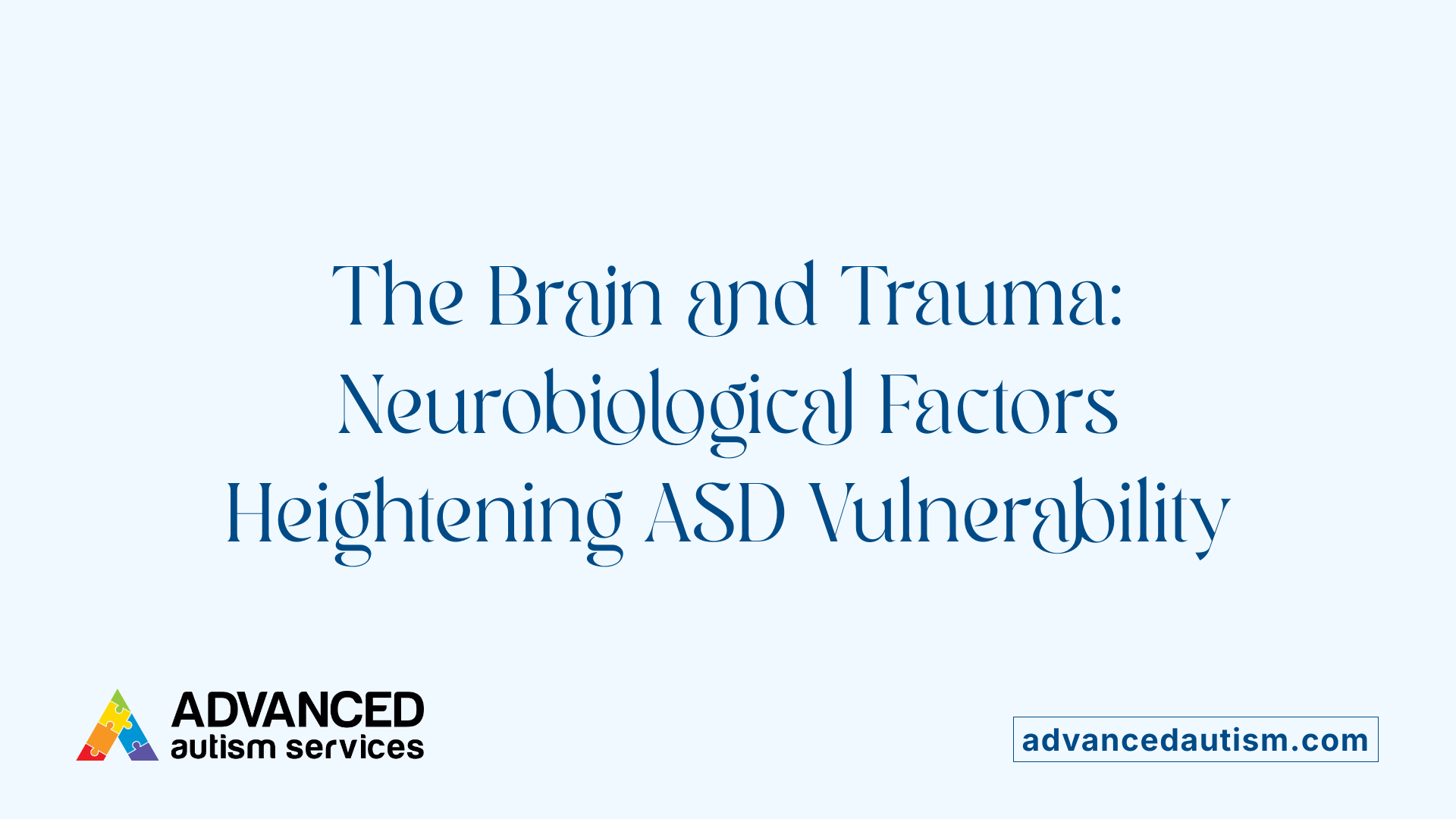
How Does HPA Axis Dysregulation Contribute to Trauma Sensitivity in ASD?
Individuals with autism spectrum disorder (ASD) often experience dysregulation of the hypothalamic-pituitary-adrenal (HPA) axis, an essential neuroendocrine system that governs the body’s stress response. This dysregulation means that the typical stress signaling pathways are impaired, affecting how stress hormones are released and regulated. As a result, people with ASD may have heightened physiological reactions to stress, making them more vulnerable to trauma.
What Role Do Elevated Cortisol Responses Play?
Cortisol is a critical hormone released during stress via the HPA axis. Research indicates that individuals with ASD often show elevated cortisol responses when exposed to stressors. This exaggerated hormonal reaction can intensify the experience of distress and may amplify the physical and emotional impact of traumatic events. Elevated cortisol also affects brain areas involved in emotion regulation and memory, which can complicate trauma symptomology in ASD.
How Do Neurobiological Factors Influence Trauma Vulnerability?
Multiple neurobiological differences in ASD contribute to increased trauma vulnerability. Besides HPA axis dysregulation and elevated cortisol, atypical brain connectivity and altered sensory processing make it difficult for some individuals to filter out and manage overwhelming stimuli. This biological sensitivity can exacerbate reactions to traumatic experiences and impact recovery processes.
Overall, neurobiological mechanisms such as HPA axis changes and cortisol imbalances create a heightened state of vulnerability to trauma in ASD. These factors influence not only the onset but also the nature of trauma symptoms, requiring trauma treatment approaches tailored to these underlying physiological differences.
Distinct Trauma Manifestations in Autism: Behavioral and Psychological Patterns
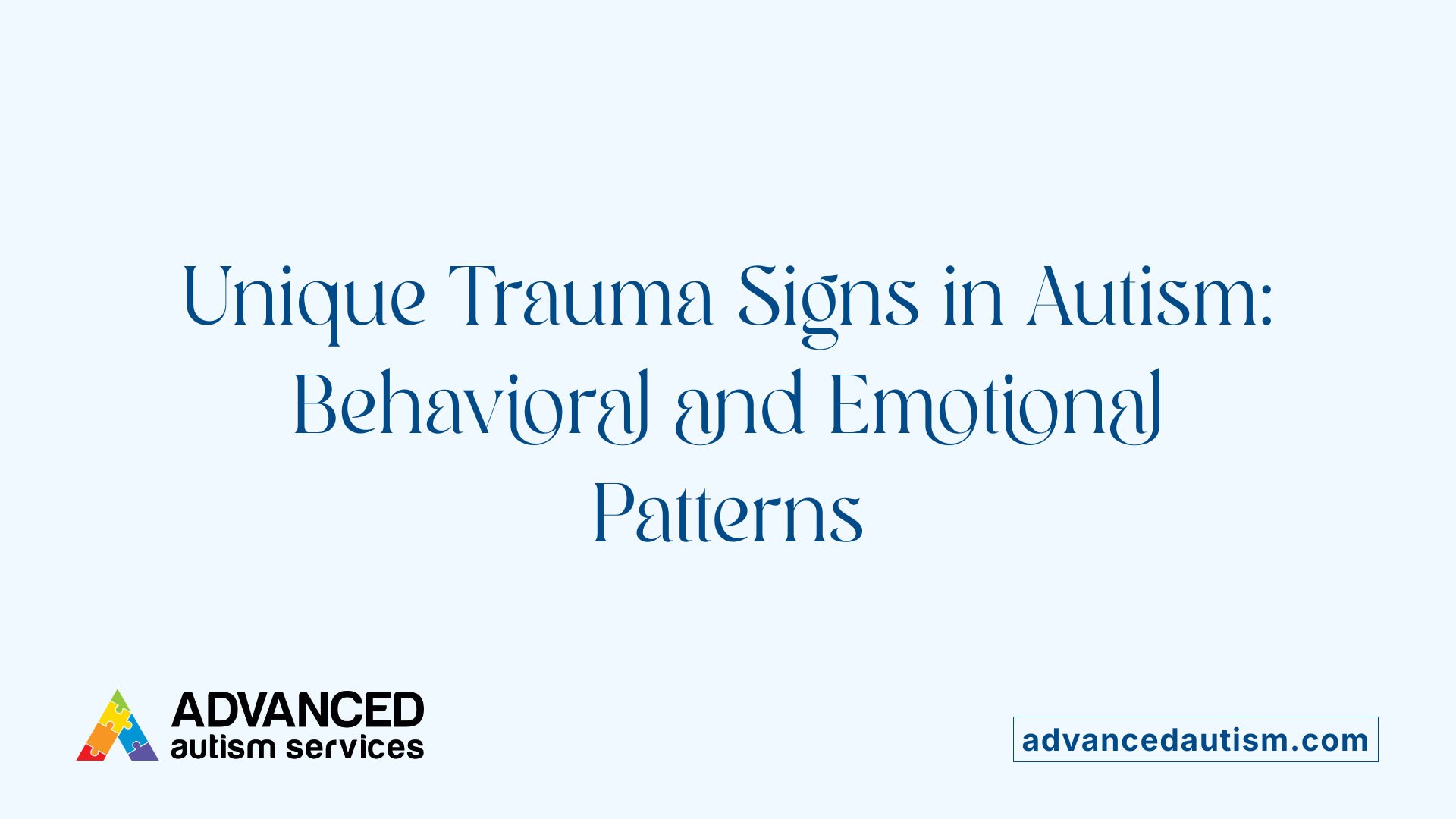
How Do Intrusive Thoughts and Distressing Memories Present in Individuals with ASD?
Trauma in people with autism spectrum disorder (ASD) often appears through intrusive thoughts and distressing memories. These traumatic recollections can be intense and confusing, challenging their ability to process emotions and social cues due to core ASD characteristics. Unlike in typical PTSD, individuals with ASD might express these memories in ways that are less verbal and more behaviorally evident.
Why Is There an Increase in Repetitive Behaviors After Trauma?
Following traumatic experiences, a notable increase in repetitive behaviors, or stereotypies, is common among those with ASD. These behaviors may serve as coping mechanisms to alleviate stress or regain a sense of predictability and control when overwhelmed by distressing memories or social confusion caused by trauma.
How Does Trauma Impact Social-Communication in ASD?
Traumatic events can intensify social-communication impairments native to ASD. Individuals may withdraw more socially, have increased difficulty interpreting social interactions, or struggle with theory of mind abilities. This worsening can affect relationships and increase feelings of isolation or misunderstanding.
What Are the Challenges in Adaptive Functioning?
Adaptive functioning often declines after trauma in individuals with ASD. This includes challenges in daily living skills such as managing emotions, understanding safety, and responding to social environments effectively. These difficulties complicate recovery and highlight the need for tailored therapeutic support.
Overall, trauma in ASD manifests uniquely with a blend of psychological and behavioral changes that intertwine with the core autism traits, mandating specialized approaches for assessment and intervention.
Co-occurrence of Autism and PTSD: Prevalence and Contributing Factors
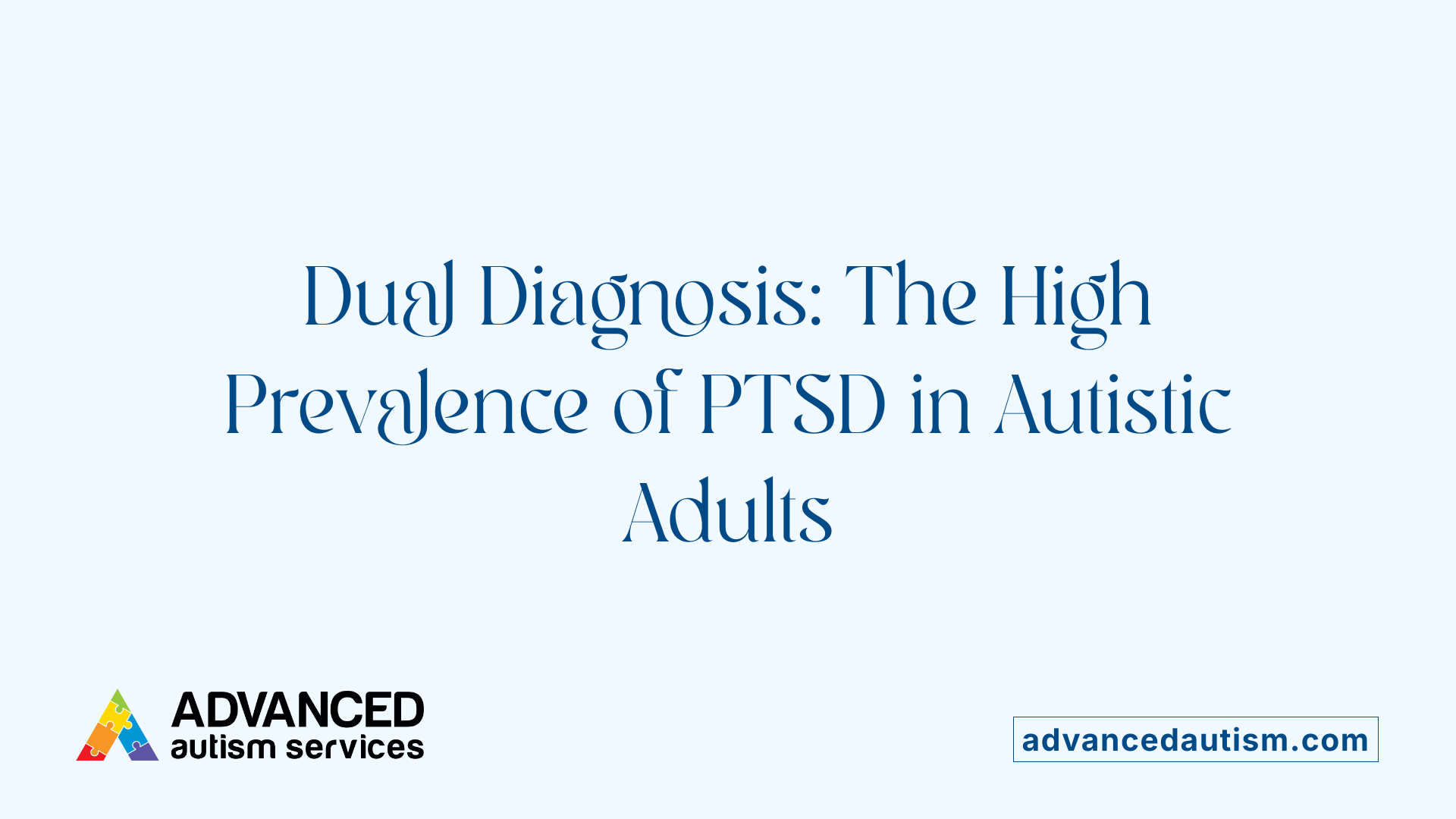
What is the prevalence of PTSD among autistic adults?
Research indicates a notably high prevalence of PTSD within the autistic adult population. Studies suggest that between 32% and 45% of autistic adults experience PTSD. This rate is substantially higher than in the general population, highlighting the increased vulnerability in individuals with autism spectrum disorder (ASD).
How do social adversity and stigma contribute to trauma in autistic individuals?
Social adversity and stigma play crucial roles in the heightened PTSD rates seen in people with ASD. Many face ongoing challenges such as bullying, exclusion, and misunderstanding due to differences in social communication and behavior. These experiences can be traumatic over time, leading to complex psychological effects including those seen in PTSD and CPTSD (complex PTSD).
What sensory factors trigger PTSD in individuals with autism?
Sensory sensitivities common in autism also contribute significantly to trauma. Heightened reactions to sensory stimuli—such as loud noises, bright lights, or crowded environments—can trigger intense stress responses. These sensory triggers may not only increase immediate distress but can also exacerbate PTSD symptoms, overwhelm emotional regulation, and result in occurrences like autistic burnout.
In summary, PTSD is disproportionately prevalent among autistic adults, influenced by cumulative social adversity, stigma, and sensory sensitivities unique to their neurodevelopmental profile. Recognizing these factors is essential for effective trauma-informed care and supports tailored to this population.
Comparing Emotional Dysregulation and Sensory Sensitivities in PTSD and Autism
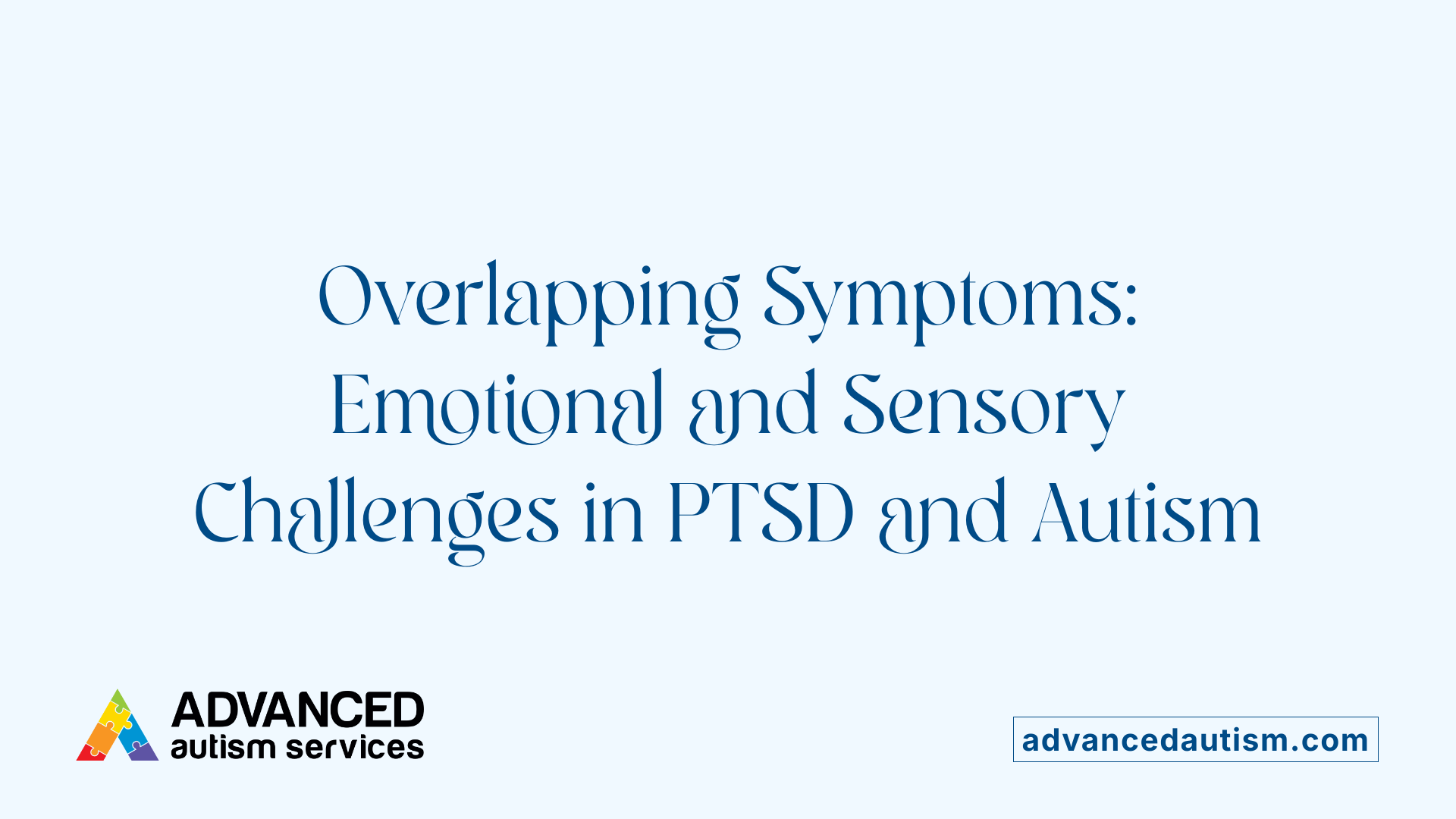
How do emotional dysregulation patterns compare between PTSD and autism?
Emotional dysregulation is a significant feature in both complex PTSD (CPTSD) and autism spectrum disorder (ASD). Individuals with CPTSD often experience difficulty managing intense emotions due to prolonged trauma exposure, leading to symptoms like mood swings, anger, and anxiety. Similarly, autistic individuals can experience emotional dysregulation, characterized by challenges in regulating feelings, which might be exacerbated by difficulties in social communication and reduced theory of mind. Although these dysregulation patterns emerge from different origins—trauma-related in CPTSD and neurodevelopmental in ASD—they can overlap and complicate diagnosis and treatment.
What role does sensory overload play in these conditions?
Sensory sensitivities are prominent in ASD, where individuals might be overwhelmed by sounds, lights, or textures. These sensory triggers can lead to heightened stress responses and behavioral challenges. In CPTSD, sensory overload can also occur, often as part of hyperarousal symptoms triggered by reminders of traumatic events. Both groups may experience intense sensory input as distressing, but in autism, it is often persistent and linked to neural processing differences, whereas in CPTSD, it is primarily trauma-associated.
How do sensory and emotional factors trigger trauma responses and autistic burnout?
In both PTSD and autism, sensory and emotional challenges can precipitate intense stress reactions. For autistic individuals, sensory overload and emotional dysregulation may lead to autistic burnout — a state of exhaustion accompanied by worsening social-communication impairments and repetitive behaviors. Similarly, trauma reminders in CPTSD evoke intrusive memories and heightened arousal that may worsen symptoms. These overlapping triggers mean that emotional and sensory difficulties can contribute to cycles of distress, requiring tailored therapeutic approaches that address both trauma and neurodevelopmental needs.
Diagnostic Frameworks: Autism Spectrum Disorder Assessment
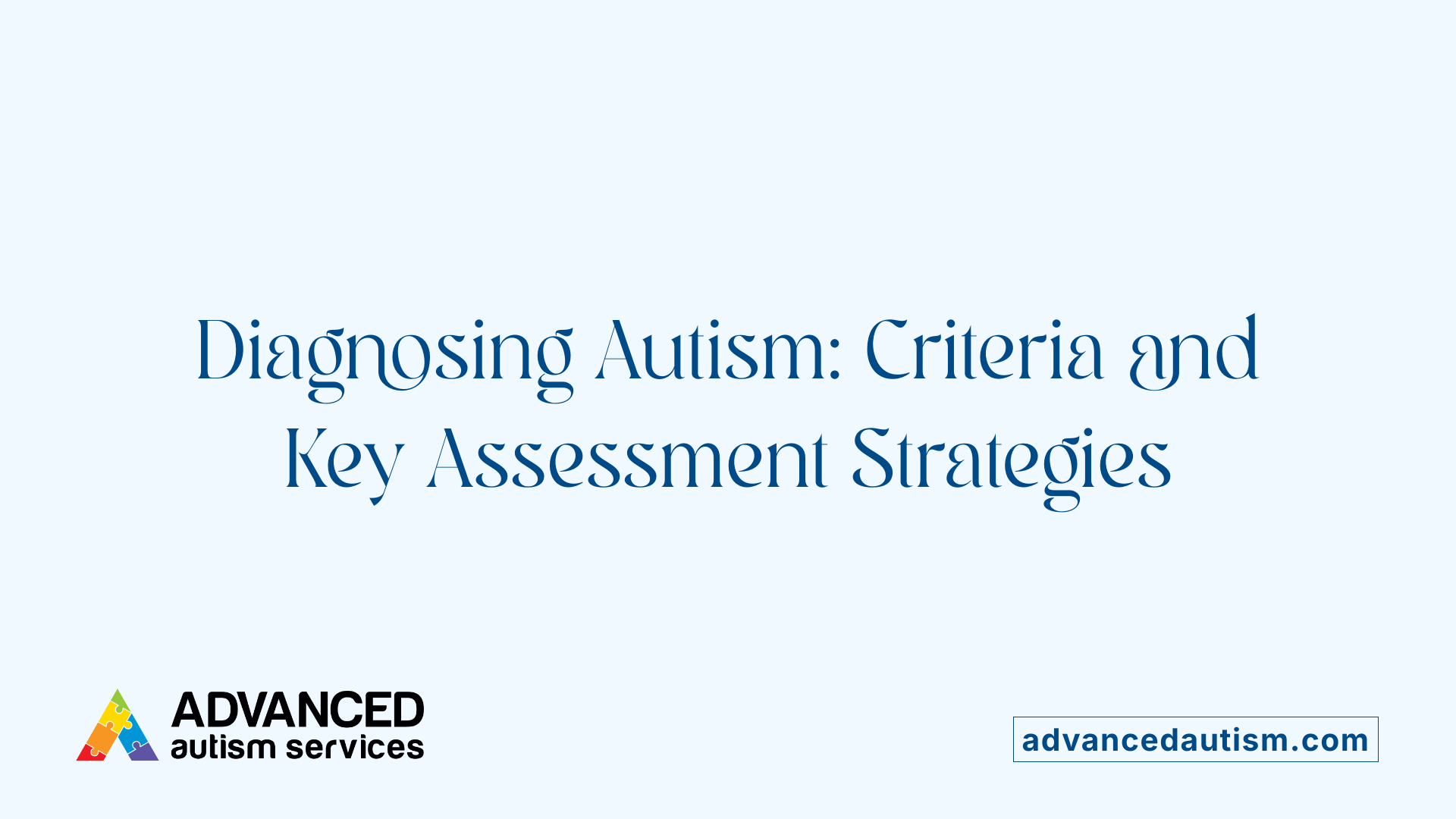
What are the DSM-5 criteria for autism diagnosis?
The DSM-5 outlines specific criteria for diagnosing Autism Spectrum Disorder (ASD). These focus on persistent challenges in social communication and social interaction across multiple contexts, as well as restricted, repetitive patterns of behavior, interests, or activities. Symptoms must be present from early developmental periods and cause clinically significant impairment in social, occupational, or other important areas of functioning.
What does the clinical interview process entail?
The clinical interview is a cornerstone of the autism diagnostic process. During this detailed assessment, clinicians gather developmental history, observe behaviors, and evaluate communication styles and social interactions. They carefully explore core ASD features such as language use, nonverbal communication, sensory processing differences, and patterns of repetitive behavior.
How does caregiver input contribute to diagnosis?
Input from caregivers and loved ones is invaluable in providing a comprehensive understanding of the individual's behavior across different settings. Since individuals with ASD may communicate or interpret social cues differently, caregivers offer critical observations about daily functioning, social relationships, and developmental milestones. This collaborative approach enhances diagnostic accuracy and informs tailored intervention strategies.
Diagnostic Criteria and Assessment of Complex PTSD
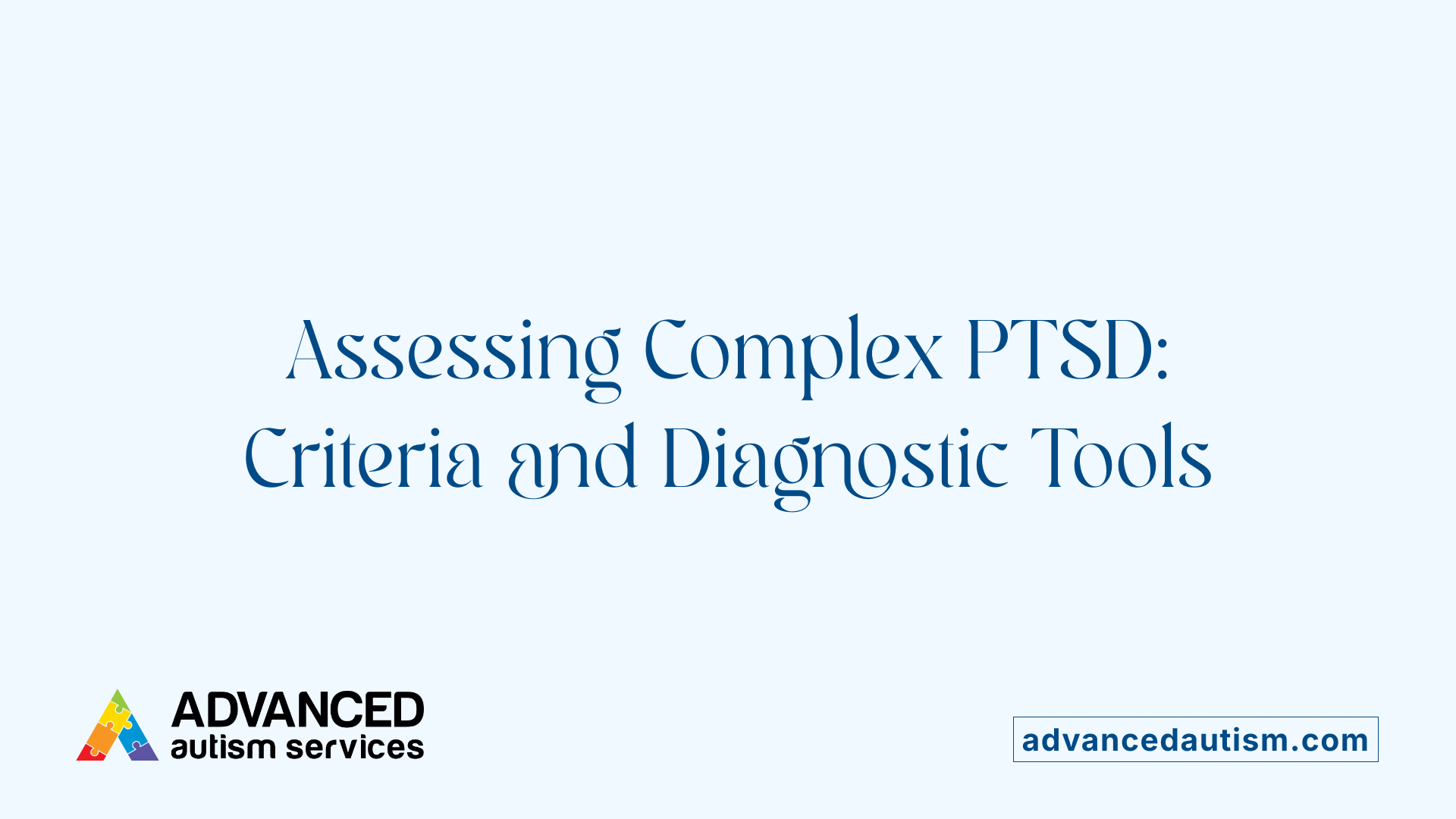
What are the ICD-11 criteria for CPTSD?
Complex Post-Traumatic Stress Disorder (CPTSD) is distinguished from traditional PTSD by its inclusion of additional symptoms involving emotional regulation and self-concept. According to the ICD-11, a CPTSD diagnosis requires evidence of exposure to prolonged or repetitive traumatic events. Core symptom clusters include re-experiencing the trauma, avoidance of trauma reminders, and persistent perceptions of heightened threat.
Beyond these PTSD symptoms, CPTSD uniquely involves disturbances in self-organization, such as deficits in emotional regulation, negative self-perception, and difficulties in relationships with others. These additions highlight the profound effects that chronic trauma has on interpersonal functioning and emotional health.
How is trauma history assessed in CPTSD?
Assessment of CPTSD begins with a detailed trauma history to establish the nature, duration, and timing of traumatic exposure. Clinicians generally take a comprehensive approach, incorporating interviews that gather data on the types of trauma experienced, including childhood maltreatment, neglect, and prolonged abuse.
This trauma history is crucial to distinguish CPTSD from other psychiatric disorders, as well as from PTSD, by confirming the presence of chronic trauma exposure. Understanding the context of trauma also guides treatment planning.
What are the symptoms of CPTSD, including interpersonal difficulties?
CPTSD symptomatology extends beyond conventional PTSD to include emotional dysregulation, which can manifest as intense mood swings or difficulties calming down. Negative self-perception often presents as feelings of worthlessness or deep shame.
Interpersonal difficulties are another hallmark; individuals may struggle with trust, maintaining close relationships, or may experience social withdrawal. These challenges reflect the extensive impact of trauma on a person's ability to relate to others.
Assessment of these symptoms requires evaluating emotional responses and interpersonal functioning, often through standardized tools and clinical observation, to fully capture the disorder's complexity.
Applied Behavior Analysis (ABA) Therapy: Foundations and Approach
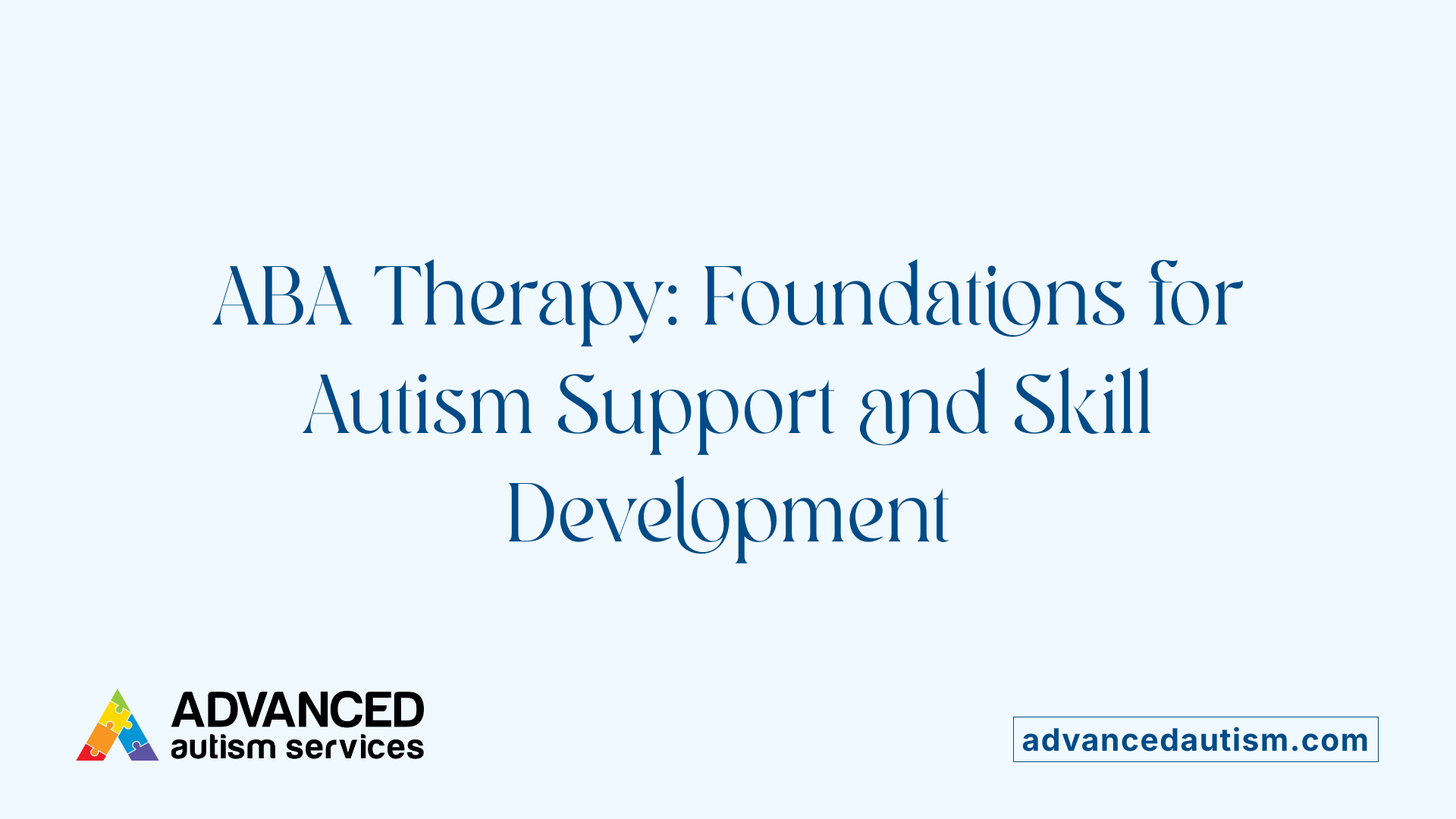
What is applied behavior analysis (ABA) therapy, and how is it used in treating autism?
Applied Behavior Analysis (ABA) therapy is an evidence-based intervention designed to support individuals with autism by improving critical social, communication, and daily living skills. ABA applies principles of learning and reinforcement to teach positive behaviors while reducing harmful or undesired behaviors.
Principles of learning and reinforcement
ABA relies on behaviorist learning principles, emphasizing that behaviors can be shaped through consequences. Positive reinforcement encourages desired behaviors by providing rewards or praise immediately after the behavior occurs. This consistent feedback loop helps individuals gradually acquire new skills and reduce problematic behaviors.
Tailored treatment plans
A key aspect of ABA is its customized approach. Each individual with autism undergoes a detailed assessment to identify specific needs, strengths, and challenges. Treatment plans are then individualized, focusing on socially significant goals such as communication, social interaction, and adaptive skills. This person-centered approach ensures that therapy targets areas essential for enhancing independence and daily functioning.
Common methodologies like Discrete Trial Training and Pivotal Response Treatment
ABA includes a variety of methodologies suited to different learning styles and goals. Discrete Trial Training (DTT) is a structured technique that breaks skills into small, teachable components delivered in quick, repeated sessions. Pivotal Response Treatment (PRT), by contrast, uses more naturalistic and child-led strategies to increase motivation and generalization of learned behaviors.
Early Start Denver Model (ESDM) is another ABA-based method combining play-based and structured learning, shown particularly effective for young children.
These methods can be used individually or in combination depending on the individual's developmental profile and needs. Early and intensive ABA therapy, especially in preschool years, has demonstrated substantial gains in cognitive, language, and social abilities, reducing future need for intensive services.
Overall, ABA therapy's focus on tailored, reinforcement-based interventions makes it a cornerstone in autism treatment, promoting meaningful skill acquisition and supporting participation in everyday life.
Who Provides ABA Therapy and How Is It Delivered?
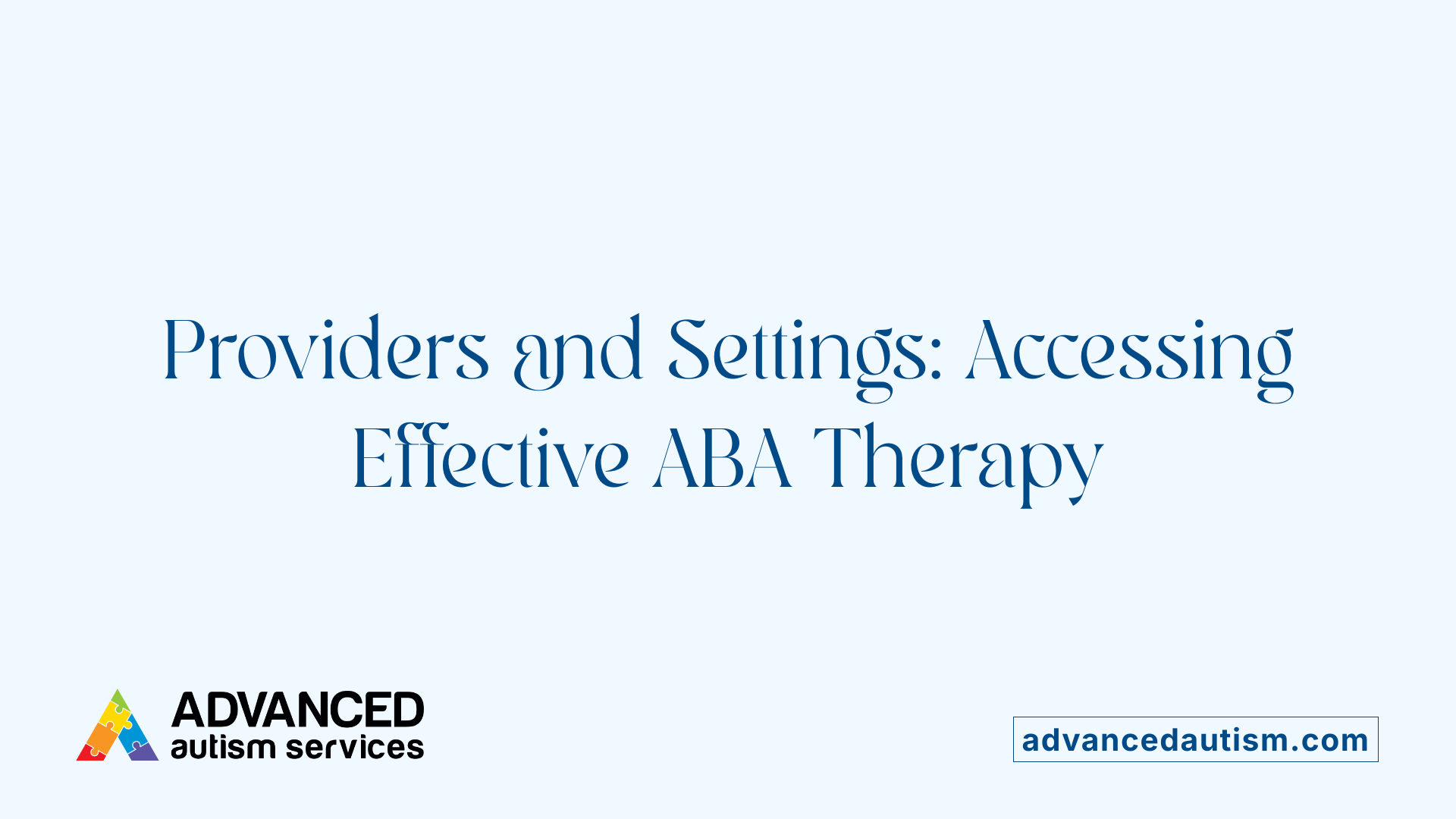
Who provides behavioral analysis therapy for autism?
Behavioral analysis therapy for autism is primarily delivered by trained professionals known as Board Certified Behavior Analysts (BCBAs). These specialists hold certifications that ensure their expertise in Applied Behavior Analysis (ABA), a therapeutic approach grounded in behavioral science.
Other licensed therapists with ABA training also provide this therapy, working under supervision or independently depending on their credentials and local regulations. These professionals design personalized treatment plans that use positive reinforcement strategies and analyze the antecedent-behavior-consequence cycle to encourage beneficial behaviors and reduce challenges.
What treatment settings are used for ABA therapy?
ABA therapy is flexible and is delivered across various environments to best suit the individual's needs. Common treatment settings include:
- Home: Familiar surroundings help generalize skills and involve family members directly in the intervention.
- School: Integrating ABA services within educational settings supports social and academic skills development.
- Community: Therapy in community settings helps practice real-world social interactions and adaptive behaviors.
This multi-setting approach ensures that therapeutic gains are consistent and applicable across daily life.
How are parents and caregivers involved in ABA therapy?
Parents and caregivers play a critical role in the success of ABA therapy. They are educated on therapy goals and techniques to reinforce skills outside of formal sessions. Active caregiver involvement includes:
- Participating in training to implement ABA strategies.
- Assisting with data collection to monitor progress.
- Helping to generalize learning by incorporating strategies into daily routines.
Their involvement bridges therapy and everyday life, enhancing outcomes for the individual with autism.
What about access and insurance coverage?
Access to ABA therapy can vary depending on geographic location, availability of qualified providers, and insurance policies. Many health insurance plans now provide coverage for ABA services, making treatment more affordable for families. However, coverage specifics and limits differ, which may affect treatment duration and intensity.
Efforts continue to expand provider networks and insurance benefits to improve access. Families seeking ABA therapy are encouraged to consult with providers and insurers to understand coverage options and identify appropriate services.
| Aspect | Description | Importance |
|---|---|---|
| Providers | Board Certified Behavior Analysts (BCBAs) and licensed ABA therapists | Ensure quality and evidence-based treatment |
| Settings | Home, school, community | Promote skill generalization and real-world application |
| Caregiver Involvement | Training and participation in therapy goals and strategies | Enhances therapy effectiveness and supports maintenance of skills |
| Access and Insurance | Coverage availability varies; insurance may cover ABA services | Affects affordability and treatment accessibility |
Personalizing ABA Therapy to Individual Needs in Autism
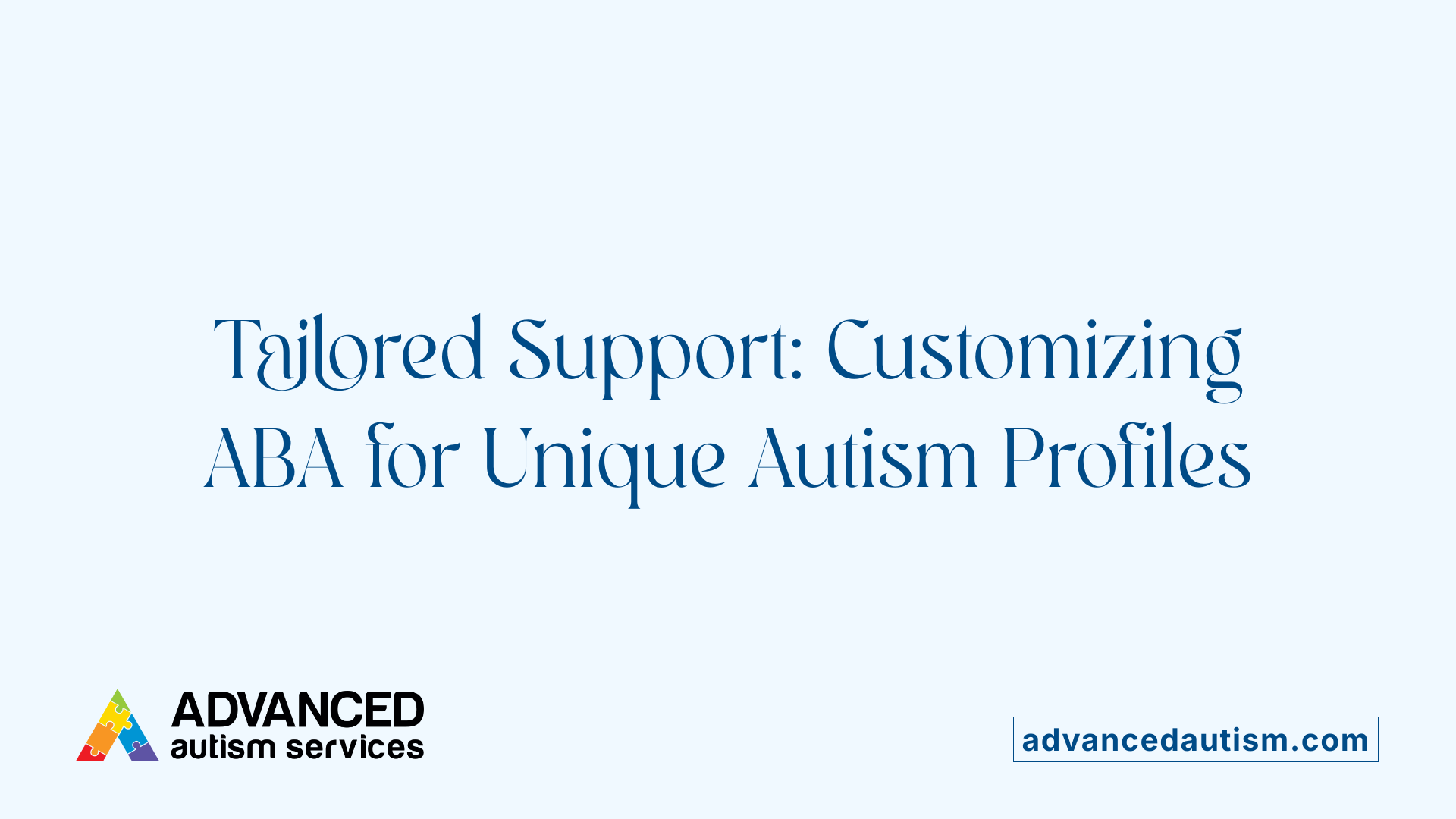
How is ABA therapy tailored to meet the needs of individuals with autism?
Applied Behavior Analysis (ABA) therapy is highly individualized to support the diverse needs of children with autism spectrum disorder (ASD). The process begins with a comprehensive behavioral assessment conducted by a Board-Certified Behavior Analyst (BCBA). This assessment gathers detailed information about the child's strengths, challenges, and specific behaviors in various settings.
Based on this data, therapists establish measurable goals targeting essential skills like communication, social interaction, and daily living activities. These goals are customized to align with the child's unique profile, ensuring relevance and practicality.
ABA makes extensive use of positive reinforcement to encourage desirable behaviors. Interventions are often delivered in natural environments—such as home or school—to promote generalization of skills. Techniques include direct instruction alongside engaging activities like games and group sessions, all designed to make learning enjoyable and effective.
Early intervention plays a critical role; initiating ABA therapy as early as 12 to 18 months can capitalize on the brain's plasticity, optimizing developmental outcomes.
Ongoing progress monitoring is essential to adapt the therapy plan as the child grows and their needs evolve. Regular data collection helps therapists fine-tune techniques, ensuring interventions remain effective and personalized.
| Aspect | Description | Benefit |
|---|---|---|
| Comprehensive Assessment | Detailed evaluation by BCBA | Identifies specific areas for intervention |
| Measurable Goals | Clear, personalized targets | Tracks progress and adjusts focus |
| Natural Environment Use | Therapy delivered in everyday settings | Enhances real-world skill application |
| Positive Reinforcement | Rewarding appropriate behaviors | Increases motivation and learning |
| Early Intervention | Starting therapy early (12-18 months) | Maximizes developmental gains |
| Progress Monitoring | Regular data collection and plan adjustment | Ensures therapy remains relevant and effective |
Main Benefits of ABA Therapy for Autism Spectrum Disorder
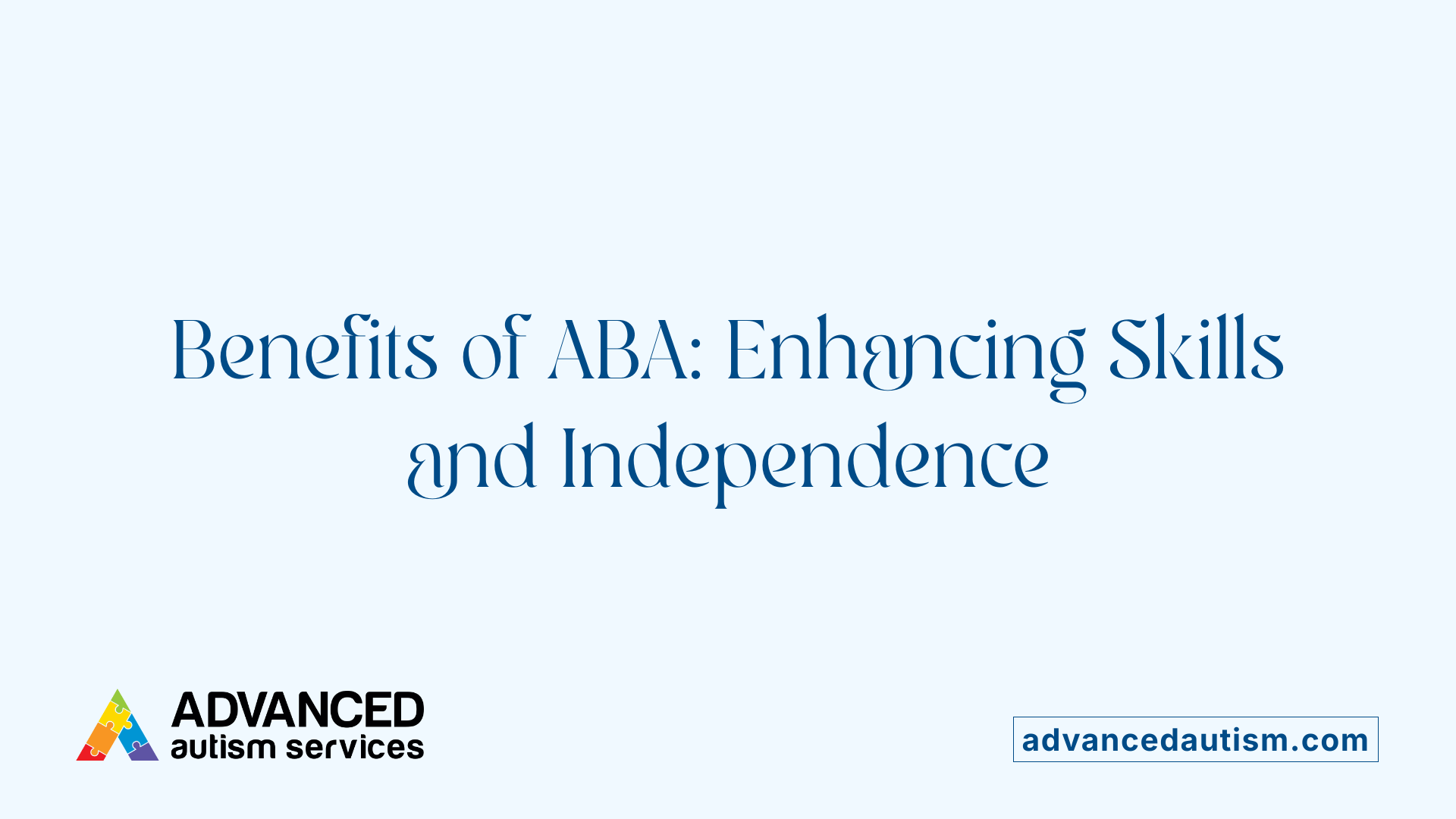
What are the main benefits of ABA therapy for individuals with autism?
Applied Behavior Analysis (ABA) therapy offers several important benefits for individuals with autism spectrum disorder (ASD). One of the most significant is improvements in communication skills, helping individuals express themselves more effectively and understand others better. This can include both verbal language and non-verbal communication methods.
ABA also fosters enhanced social interactions, teaching skills such as initiating conversations, making friends, and engaging in group activities. These social skills are crucial for building relationships and participating successfully in everyday life.
A core area of ABA is the reduction of challenging behaviors. By identifying triggers and replacing problematic actions with more appropriate responses, ABA helps decrease behaviors that interfere with learning and socialization.
Furthermore, ABA supports the development of adaptive and independent skills. These include daily living activities like self-care, toileting, and managing routines, all of which contribute to greater independence and improved quality of life.
Lastly, ABA addresses emotional regulation by teaching coping strategies that help manage emotions and reduce anxiety or frustration, which are often heightened in autism.
When ABA therapy is started early and tailored to an individual's unique needs, it can promote meaningful developmental progress and greater autonomy across multiple areas of functioning.
Trauma-Specific Challenges in Autism: Why Standard PTSD Treatments May Fall Short
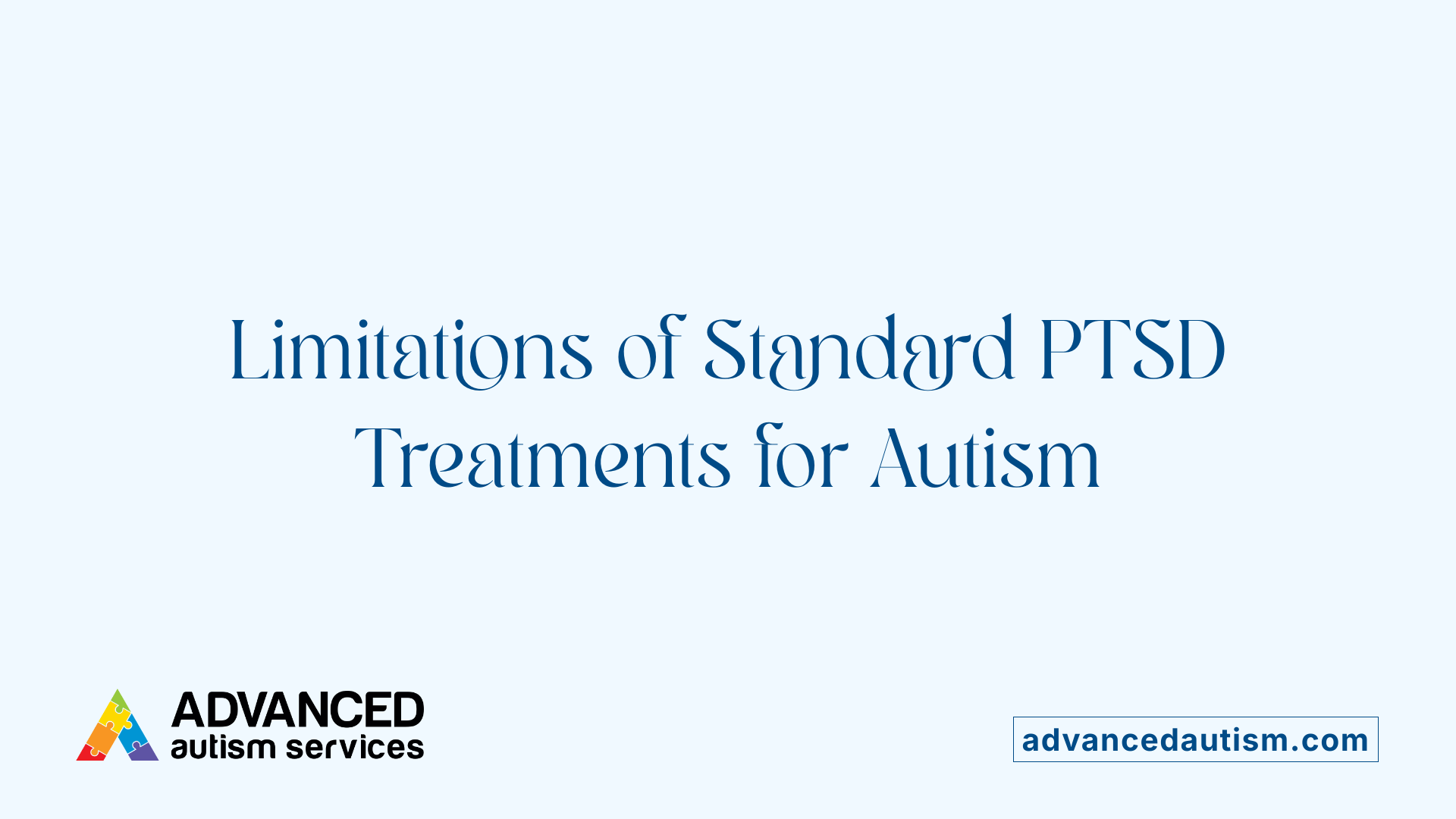
How Do Core ASD Deficits Affect Trauma Manifestations?
Individuals with autism spectrum disorder (ASD) often experience trauma differently because of foundational challenges in social communication, theory of mind, and repetitive behaviors. These core deficits influence how trauma symptoms appear. For example, difficulties recognizing and interpreting emotions can make it harder for autistic individuals to identify and express distress related to trauma. Instead of typical PTSD symptoms, they might show increased stereotypic behaviors, worsening social communication, or struggles with adaptive functioning.
Why Is It Difficult for Some with ASD to Recognize and Communicate Emotions?
Many autistic individuals interpret social cues literally and focus on details rather than emotional context. This can create barriers in understanding their own trauma symptoms or communicating them to clinicians. Additionally, sensory sensitivities common in ASD may amplify stress responses, resulting in heightened emotional dysregulation that may not be easily captured by traditional trauma assessments.
What Are the Limitations of Conventional PTSD Treatments for ASD?
Traditional PTSD treatments often rely heavily on verbal communication and abstract thinking, which can be challenging for people with ASD. Standard Trauma-Focused Cognitive Behavioral Therapy (TF-CBT) approaches may not fully address the unique ways trauma presents in autism, such as behavioral changes or sensory-related distress. Without modifications, therapy may fail to engage autistic individuals effectively or address their specific needs.
Why Is There a Need for Specialized Trauma Assessment Tools?
Current trauma assessments are typically designed for neurotypical populations and might miss subtle or atypical trauma signs in ASD. Because trauma can manifest as behavioral changes rather than explicit emotional complaints, specialized tools that incorporate visual supports and caregiver input are necessary. Developing empirically supported, ASD-sensitive assessments is critical to accurately identify trauma and guide effective, tailored interventions.
Adapting Trauma-Focused Cognitive Behavioral Therapy (TF-CBT) for Individuals with Autism
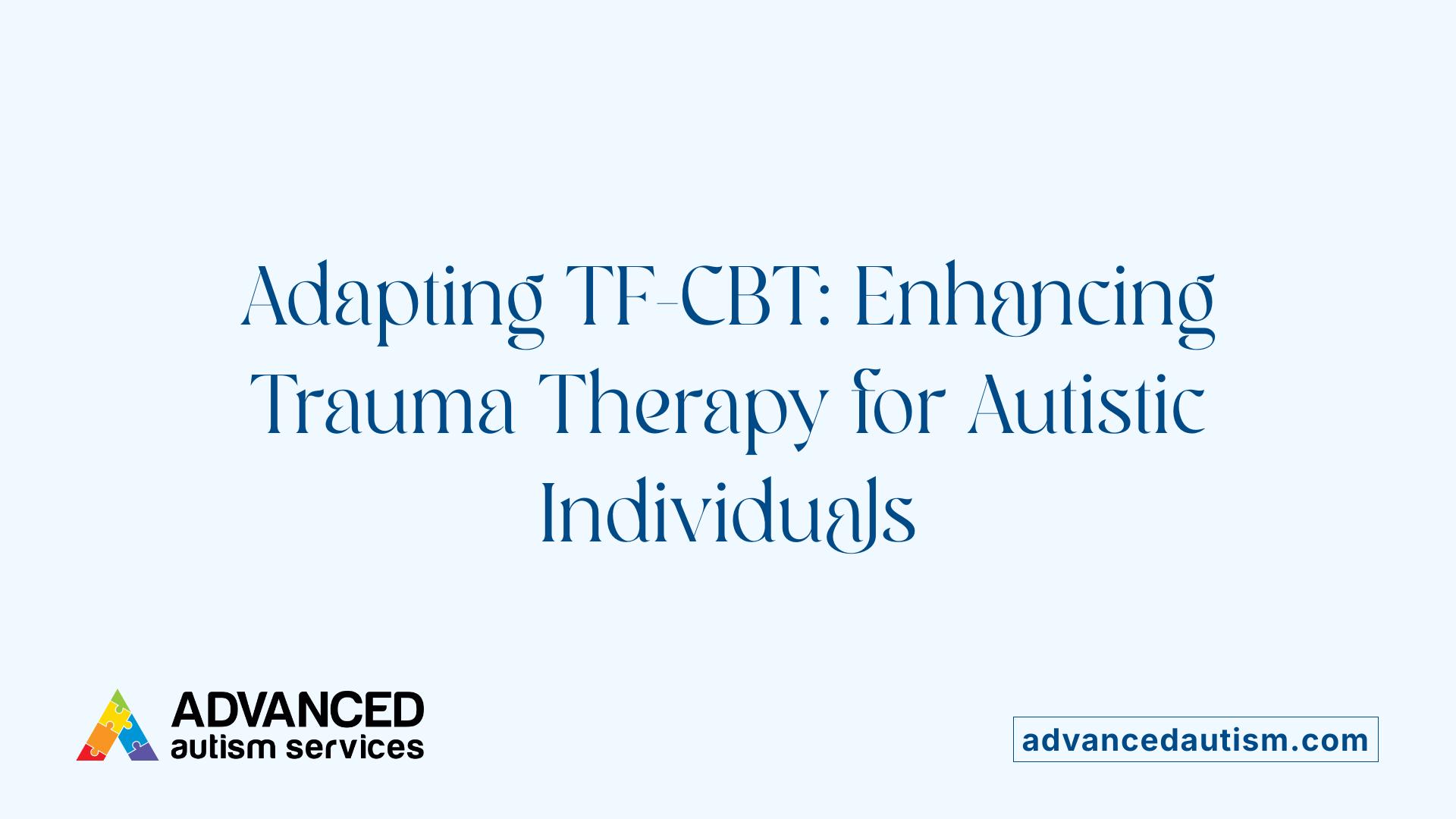
Visual Supports and Social Stories
Using visual schedules and social stories is crucial in adapting TF-CBT for individuals with autism. These tools help structure sessions clearly and predictably, reducing anxiety by making abstract concepts more concrete. They guide autistic individuals through therapy steps, enhancing understanding and engagement.
Simplified and Concrete Language
Simplified language tailored to the individual's comprehension style is essential. Concrete, literal language avoids confusion caused by idioms or abstract terms, making trauma-related content accessible. This approach respects the communication preferences common in autism, where detailed and precise language aids learning.
Augmentative Communication Methods
For individuals with limited verbal skills, augmentative communication methods such as picture exchange systems or communication devices are integrated into therapy. These tools empower clients to express feelings and experiences related to trauma effectively, facilitating better therapeutic interaction.
Caregiver Involvement
Active involvement of caregivers enhances therapy outcomes. Caregivers support the transfer of skills learned during sessions to daily life and provide emotional stability. They also help reinforce social and safety behaviors taught, ensuring consistency and reinforcing progress outside therapy.
Teaching Social and Safety Behaviors
Explicit teaching of social and safety behaviors is incorporated to address social communication challenges. Therapists use role-playing and modeling to teach recognizing social boundaries, appropriate interactions, and safety awareness, which are pivotal for reducing vulnerability to trauma and promoting resilience.
Adaptations like these make TF-CBT more responsive to the unique needs of autistic individuals, enhancing both comprehension and emotional processing capabilities during trauma treatment.
The Role of Caregivers and Systemic Factors in Treating Trauma in Autism
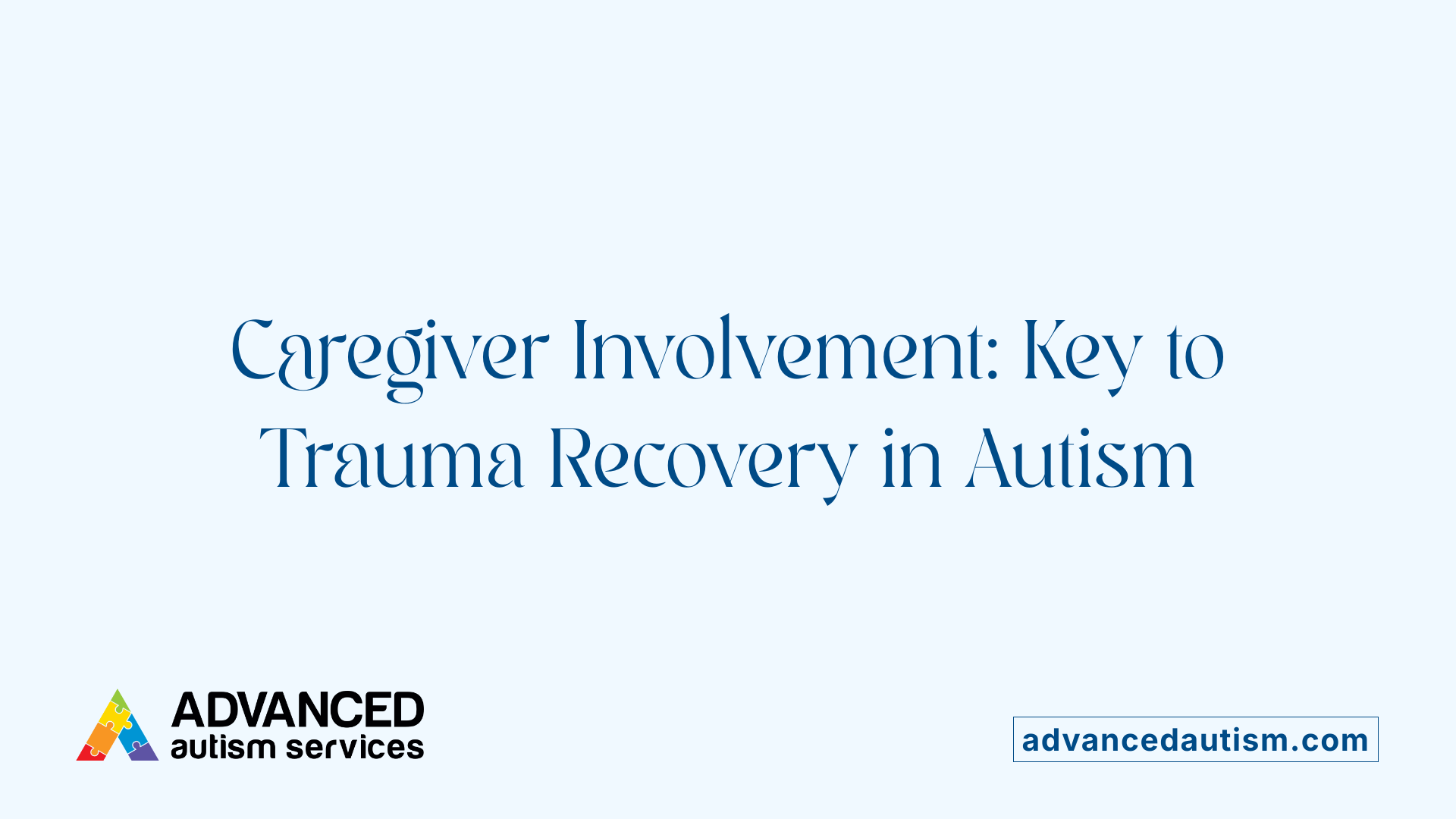
Why is caregiver involvement critical in trauma treatment for individuals with ASD?
Caregivers play an essential role in trauma therapy for individuals with autism spectrum disorder (ASD). Given the communication and comprehension challenges often present in ASD, caregivers act as vital anchors in the therapeutic process. Their involvement ensures that treatment adaptations—such as the use of visual schedules and social stories—are consistently implemented and reinforced both in therapy sessions and daily life.
Caregivers also provide emotional support, help interpret behavioral changes, and can recognize when trauma symptoms arise or worsen. Their participation enhances the effectiveness of interventions like Trauma-Focused Cognitive Behavioral Therapy (TF-CBT), especially when therapy is tailored with concrete language and augmentative communication techniques.
How do environmental and systemic adaptations support trauma recovery in ASD?
The settings in which individuals with ASD receive trauma care must be adapted to meet their neurological and behavioral needs. Environmental modifications might include quiet, low-stimulation spaces to prevent sensory overload and the use of clear visual aids to assist understanding.
Systemic adaptations extend to involving schools, healthcare providers, and families collaboratively. Creating a predictable, structured environment that respects social and sensory sensitivities reduces stress and fosters a safer space for trauma processing. This systemic approach recognizes that trauma recovery is not isolated to therapy but occurs within a complex web of daily interactions and supports.
How do neurological and behavioral features influence trauma perception and response in ASD?
Individuals with ASD exhibit neurobiological differences such as dysregulation of the hypothalamic-pituitary-adrenal (HPA) axis and heightened cortisol responses to stress. This physiological sensitivity can amplify trauma reactions, leading to distinct patterns of symptoms, such as increased repetitive behaviors and intensified social-communication difficulties.
Behaviorally, impairments in theory of mind and emotion recognition influence how trauma is perceived and expressed. This necessitates trauma interventions that are carefully adapted to accommodate literal interpretation and social naiveté. Understanding these neurological and behavioral factors informs caregivers and clinicians to respond with patience and flexibility, fostering improved trauma recovery outcomes.
Future Directions: Developing ASD-Sensitive Trauma Assessments and Treatments
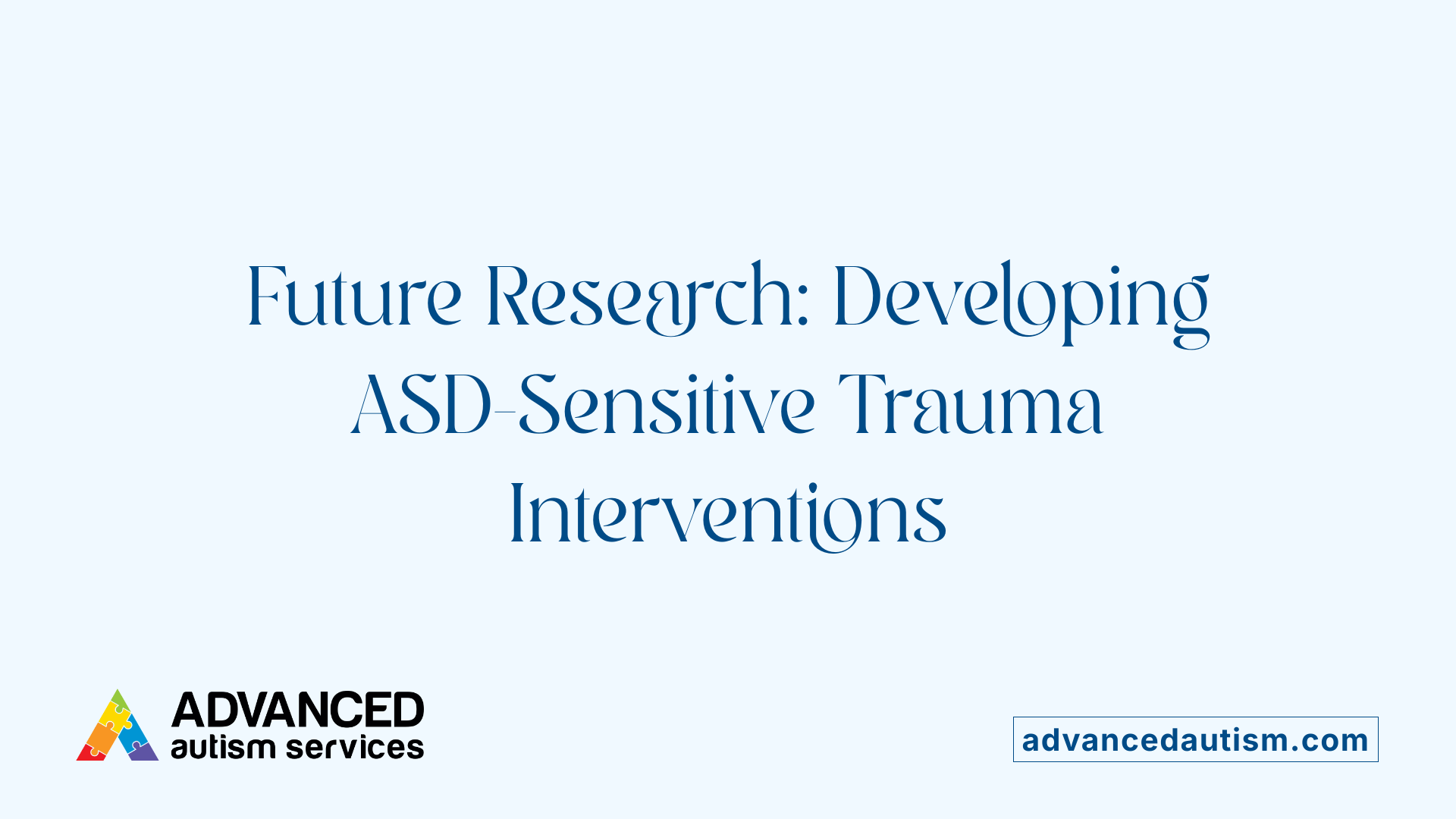
Why is there a need for ASD-specific trauma assessment tools?
Current trauma assessments often do not fully account for the unique neurobiological and behavioral characteristics of individuals with autism spectrum disorder (ASD). Because ASD affects social communication, sensory processing, and behavior, trauma symptoms may present differently, making traditional measures less sensitive or accurate. For example, increased stereotypies or communication challenges may mask or mimic trauma responses, necessitating tools that capture these nuances.
What research is needed to create tailored therapies?
Rigorous research is essential to develop and validate trauma interventions adapted for ASD. Studies should focus on modifying existing therapies like Trauma-Focused Cognitive Behavioral Therapy (TF-CBT) to incorporate visual supports, simplified language, and caregiver involvement. Clinical trials involving diverse age groups and intellectual abilities within the autism spectrum will help identify effective strategies and improve generalizability. Additionally, investigating neurobiological markers such as HPA axis dysregulation could guide personalized treatment planning.
How can these efforts bridge current gaps in trauma care for autistic individuals?
Developing empirically supported, ASD-sensitive assessment tools and treatments will enhance clinicians' ability to accurately diagnose and treat trauma within this population. Tailored approaches can reduce misdiagnosis, improve symptom management, and promote functional adaptive skills. This holistic strategy requires integrating caregivers and systems to support autistic individuals effectively. Ultimately, these advancements aim to close the existing disparity in trauma care and improve mental health outcomes for those with ASD.
Sensory Sensitivities: A Shared Feature Impacting PTSD and Autism Experience
How Are Sensory Sensitivities Heightened in Autism and PTSD?
Individuals with autism spectrum disorder (ASD) commonly experience atypical sensory processing, which amplifies their responses to sensory stimuli. This heightened sensory reactivity also intersects with symptoms of complex post-traumatic stress disorder (CPTSD), as both conditions involve sensory sensitivities that impact emotional regulation.
In ASD, sensory sensitivity may manifest as an intense awareness or discomfort triggered by loud noises, bright lights, or touch. Similarly, people with PTSD indicate that sensory input such as certain sounds or smells can recall traumatic memories, intensifying distress.
How Does Sensory Overload Act as a Trauma Trigger?
Sensory overload occurs when an individual is bombarded with excessive sensory stimuli beyond their capacity to process effectively. For those with ASD and PTSD, sensory overload can escalate feelings of fear, anxiety, and emotional dysregulation.
In autistic individuals, sensory overload may precipitate behaviors like increased repetitive actions or withdrawal, which can mirror or worsen trauma symptoms. For individuals with CPTSD, sensory triggers can provoke flashbacks or emotional outbursts, making sensory environments a critical factor in trauma responses.
What Strategies Can Help Manage Sensory Sensitivities to Prevent Crisis?
Effective management requires proactive approaches to minimize sensory overwhelm and build coping skills. Strategies include:
- Utilizing visual schedules and social stories to prepare for sensory experiences
- Implementing environmental modifications like noise-cancelling headphones or dim lighting
- Employing augmentative communication to express discomfort early
- Engaging caregivers to support safe and consistent routines
Addressing sensory sensitivities is essential for trauma-informed care tailored to ASD, helping prevent crisis moments by reducing triggers and enhancing emotional stability.
Social Communication Differences that Influence PTSD Presentation in Autism
How do literal interpretation of language and difficulty with social cues affect trauma in individuals with ASD?
Individuals with autism spectrum disorder often interpret language very literally, which can complicate their understanding and processing of traumatic events. This literal interpretation means metaphors, idioms, or indirect speech may be misunderstood or missed entirely, affecting how trauma is experienced and expressed. For example, a commonly used phrase to console someone might not be perceived as intended, potentially increasing confusion and distress.
What role do social communication challenges play in trauma experience and reporting?
Difficulty recognizing and interpreting social cues can also hinder individuals with ASD from accurately identifying danger or understanding others' intentions, increasing vulnerability to trauma. These challenges can result in delayed or atypical trauma symptom reporting, as individuals may struggle to communicate their feelings or experiences effectively. Consequently, trauma may manifest more through behavioral changes, such as increased repetitive behaviors or withdrawal, rather than explicit verbal accounts.
Impact on trauma experience and treatment approaches
The social communication deficits characteristic of autism shape how trauma symptoms present and how individuals convey their distress. Therapies addressing PTSD in ASD populations often adapt by using concrete language, visual aids, and social stories to facilitate understanding and communication. Recognizing these communication differences is essential for accurate trauma assessment and the development of tailored, effective treatment strategies.
| Aspect | Influence on Trauma in ASD | Treatment Adaptation |
|---|---|---|
| Literal Interpretation | Misunderstanding indirect speech hinders emotional processing | Use of clear, concrete language |
| Difficulty with Social Cues | Challenges in perceiving threat or safety | Use of visual schedules and social stories |
| Trauma Reporting | Behavioral manifestations may replace verbal reports | Inclusion of caregiver input and augmentative communication |
Understanding these communication nuances enables clinicians and caregivers to better support autistic individuals dealing with trauma, improving outcomes in PTSD treatment.
Understanding Repetitive Behaviors and Their Role in Trauma Response in ASD
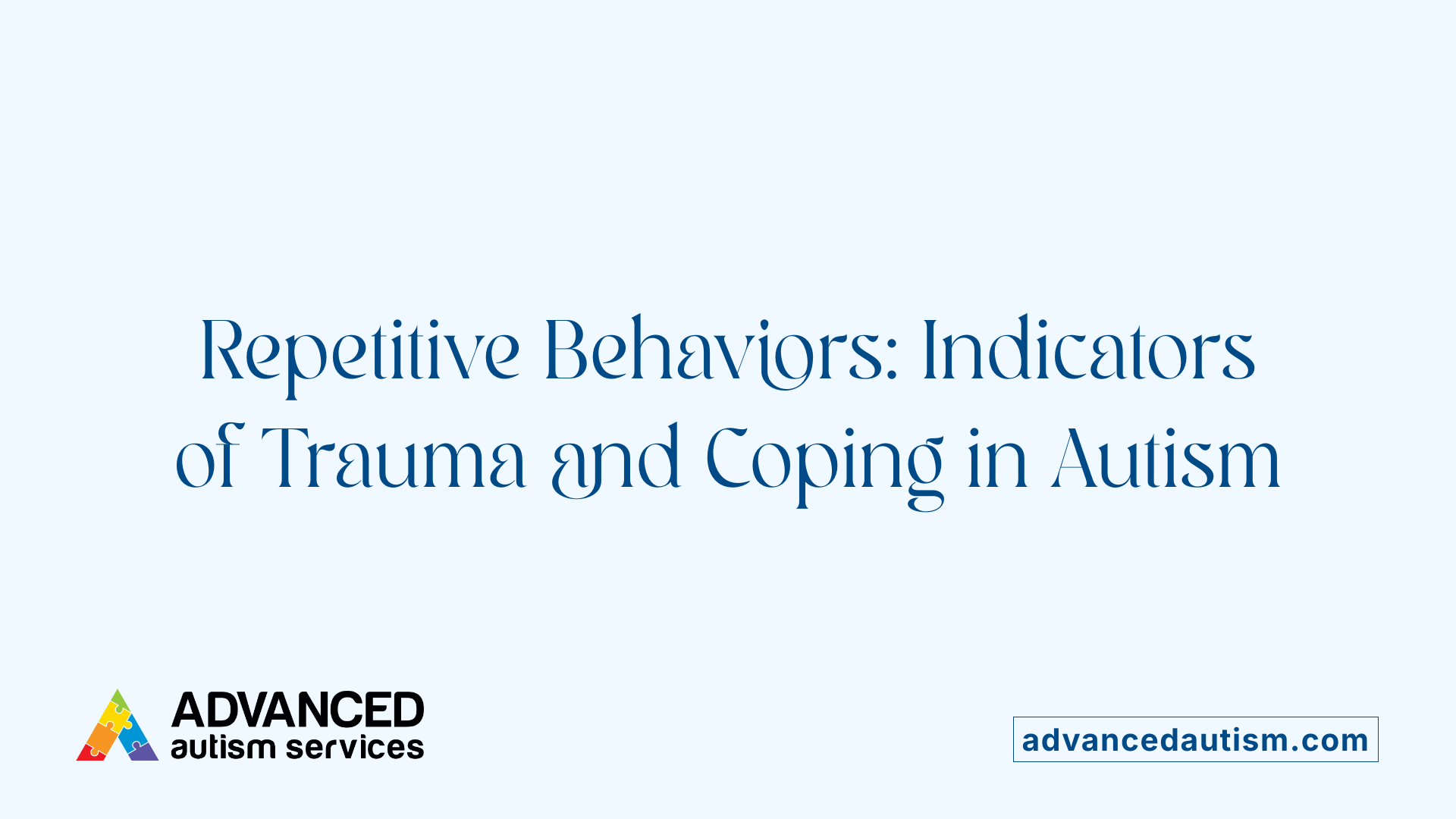
How Does Trauma Affect Stereotypies in Individuals with ASD?
Trauma can lead to an increase in stereotypies, which are repetitive behaviors often seen in individuals with autism spectrum disorder (ASD). After experiencing trauma, these behaviors may intensify as the individual struggles to manage distressing emotions or intrusive memories.
Why Do Repetitive Behaviors Serve as Coping Mechanisms?
Repetitive behaviors can function as effective coping strategies for those with ASD facing traumatic stress. They provide a predictable and calming routine that helps regulate sensory input and emotional overload. This self-soothing mechanism can temporarily reduce anxiety and create a sense of safety in overwhelming situations.
How Can Baseline Behaviors Be Distinguished From Trauma Symptoms?
Distinguishing typical repetitive behaviors from those triggered or worsened by trauma is crucial for accurate assessment and treatment. Clinicians and caregivers should carefully observe changes in frequency, intensity, or context of these behaviors. An increase in repetitive actions following a stressful event, accompanied by new symptoms like intrusive thoughts or heightened distress, may suggest a trauma-related exacerbation rather than baseline ASD behavior.
Repetitive behaviors in ASD are thus both characteristic traits and potential indicators of trauma response. Understanding their dual role aids in tailoring interventions that address not only autistic traits but also the impact of trauma, facilitating better therapeutic outcomes.
Emotional Regulation Difficulties: Overlapping Symptomatology of PTSD and Autism
Intense Emotions and Regulation Challenges
Both autism spectrum disorder (ASD) and complex post-traumatic stress disorder (CPTSD) share difficulties with emotional regulation. Individuals with ASD commonly experience sensory sensitivities and heightened emotional responses, which can lead to intense feelings that are challenging to control. Similarly, CPTSD involves emotional dysregulation as a core symptom, characterized by mood swings, heightened anxiety, and difficulty soothing oneself during distress.
Impact on Coping Strategies
The overlap in emotional challenges affects how individuals manage stress and trauma. For autistic individuals, intense emotions combined with social communication differences may impair their ability to recognize or express trauma-related feelings effectively. This can result in behaviors such as increased repetitive movements or withdrawal, which serve as coping mechanisms but may also hinder trauma processing and social interactions.
Therapeutic Approaches Addressing Emotional Dysregulation
Effective treatments for emotional regulation in ASD and CPTSD often rely on tailored psychotherapy. Trauma-focused cognitive behavioral therapy (TF-CBT) is adapted for autistic individuals by integrating visual supports, simplified language, and caregiver involvement to strengthen emotional insight and coping skills. Additionally, approaches like EMDR used in CPTSD treatment can be modified to accommodate autistic communication styles. Supporting emotional regulation is crucial in therapy to mitigate the intensity of trauma symptoms and improve overall functioning.
Therapeutic Approaches for Co-Occurring Autism and PTSD
How is trauma-informed care integrated with autism interventions?
Trauma-informed care for individuals with autism spectrum disorder (ASD) requires thoughtful adaptations to address unique neurological and behavioral features. Integration involves combining autism-specific supports such as visual schedules, social stories, and simplified language with trauma-focused therapies. Caregiver involvement is crucial to bridge understanding and reinforce treatment gains. This combined approach respects the communication challenges and sensory sensitivities prevalent in ASD, facilitating better processing of traumatic experiences.
What roles do CBT and EMDR play in treatment?
Cognitive Behavioral Therapy (CBT), particularly trauma-focused CBT (TF-CBT), is widely adapted for younger individuals with ASD and intellectual disabilities. Modifications include using concrete language, visual aids, and caregiver participation to improve comprehension and engagement. Eye Movement Desensitization and Reprocessing (EMDR) is another trauma-informed psychotherapy used primarily for PTSD and complex PTSD (CPTSD). Both therapies aim to reduce trauma symptoms and improve coping but require tailoring to accommodate ASD-related social and communication differences.
How is medication used in managing symptoms?
Medication management supports the treatment of co-occurring symptoms such as anxiety, depression, or emotional dysregulation common in both ASD and PTSD. While medications do not treat trauma directly, they can alleviate distressing symptoms that interfere with psychotherapy and daily functioning. Clinicians often combine pharmacological approaches with psychotherapy to optimize outcomes.
Why are accommodations in school and work settings important?
Accommodations are essential to address sensory sensitivities, communication needs, and emotional regulation difficulties seen in co-occurring ASD and PTSD. Adjustments might include providing quiet spaces to reduce sensory overload, clear and direct instructions, flexible scheduling, and supportive supervision. Such accommodations promote safer, more supportive environments that reduce trauma triggers and help individuals maintain adaptive functioning in educational and occupational contexts.
The Importance of Early Diagnosis for Improved Outcomes in Autism and Trauma
What Is the Role of Early Developmental Screening?
Early developmental screening plays a crucial role in identifying autism spectrum disorder (ASD) at a stage when interventions can have the most significant impact. ASD is characterized by differences in social communication and sensory processing that emerge in early childhood. Detecting these characteristics early helps clinicians plan effective supports. Screening involves observing behaviors, communication styles, and social interactions and engaging caregivers to provide comprehensive insights.
Why Is Timely Identification of Trauma Symptoms Critical?
Children and adults with ASD are at an increased risk of trauma, including bullying and victimization, partly due to difficulties understanding social boundaries and heightened sensory sensitivities. Early recognition of trauma symptoms—such as intrusive memories, emotional dysregulation, or worsening social impairments—is essential. Timely identification prevents the exacerbation of symptoms and reduces the risk of complex post-traumatic stress disorder (CPTSD), which may co-occur with ASD and presents with emotional and interpersonal challenges.
What Are the Benefits of Early Intervention?
Early intervention, informed by prompt diagnosis and trauma identification, improves long-term outcomes. Tailored therapies such as modified Trauma-Focused Cognitive Behavioral Therapy (TF-CBT) that accommodate communication and behavioral challenges can be more effective when started early. Early caregiver involvement and adapted interventions that use visual supports and simplified language have shown empirical support in reducing trauma symptoms and enhancing adaptive functioning.
Overall, combining early developmental screening with trauma symptom monitoring creates an integrated pathway to support individuals with ASD. This approach addresses both neurodevelopmental challenges and trauma-related needs, reducing the burden of symptoms and supporting healthier social and emotional development.
Advocacy and Support Systems for Individuals Facing Both Autism and PTSD
Building Supportive Environments
Creating supportive environments for individuals with both autism and PTSD involves understanding their unique challenges related to communication, sensory sensitivities, and trauma symptoms. Environments that reduce sensory overload and provide clear, visual cues can help minimize stress and promote emotional regulation. Such accommodations improve adaptive functioning and allow individuals to feel safe and understood.
Role of Peer and Family Advocacy
Peer and family advocacy play a vital role in protecting and empowering those facing dual diagnoses of autism and PTSD. Family members often act as crucial supporters in navigating social services and healthcare systems. They also help by reinforcing therapeutic strategies at home, such as those involved in modified trauma-focused cognitive behavioral therapy. Peers, especially those knowledgeable about these conditions, contribute to reduced isolation and provide social understanding.
Education for Professionals on Co-Morbid Conditions
Educating healthcare providers, educators, and social workers about the complexities of co-occurring autism and PTSD is essential. Training should emphasize recognizing how trauma symptoms may present differently in autistic individuals and the importance of tailored trauma-informed care. Professional awareness supports early diagnosis, accurate assessment, and appropriate interventions, optimizing treatment outcomes.
Advocacy efforts must prioritize collaboration amongst families, clinicians, and community organizations to design and implement systemic changes that accommodate the neurological and behavioral features influencing trauma responses in autism. This multi-faceted support system fosters resilience and improves quality of life for individuals living with both conditions.
Challenges in Accessing Specialized Behavioral and Trauma Therapies
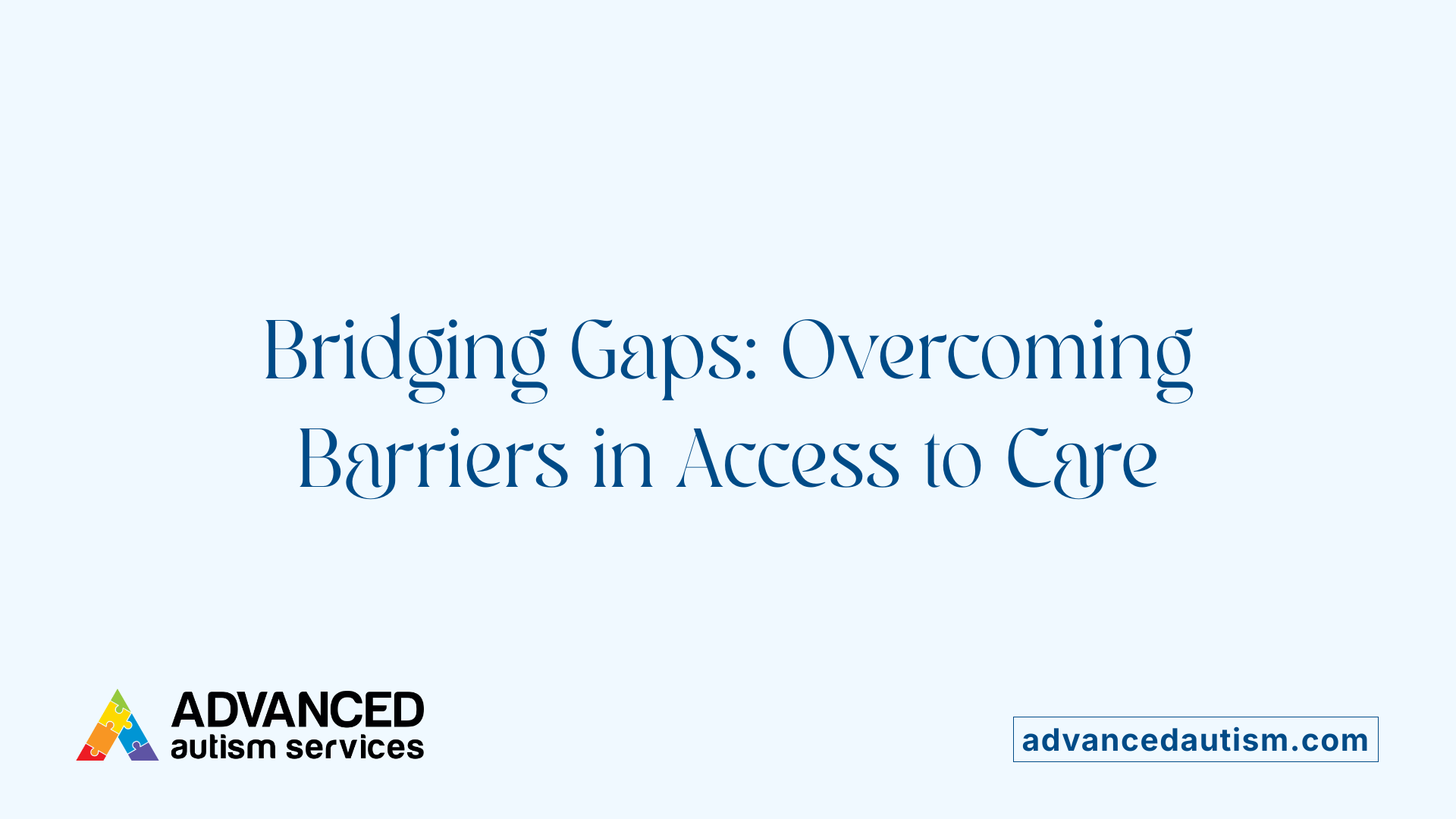
Availability of Qualified Providers
Access to specialized therapies for individuals with autism spectrum disorder (ASD) and trauma-related conditions such as complex PTSD (CPTSD) is often limited by a shortage of qualified providers. Clinicians trained both in ASD and trauma-informed approaches, including adaptations like modified Trauma-Focused Cognitive Behavioral Therapy (TF-CBT), remain relatively scarce. This scarcity can delay or reduce access to appropriate treatment that meets the unique needs posed by ASD's communication and behavioral profiles.
Barriers Including Cost and Geographic Location
Cost is a significant obstacle for many seeking behavioral and trauma therapies. Specialized interventions often require insurance coverage or substantial out-of-pocket expenses, which may not be affordable for all families. Geographic location further restricts access, as rural or underserved areas typically lack practitioners with expertise in ASD-sensitive trauma care. This inequality limits early intervention opportunities and continuous support, which are crucial for effective outcomes.
Need for Increased Resources and Policies
Addressing these access challenges calls for increased investment in training more providers equipped to handle the complexities of ASD combined with trauma. Policies should incentivize service provision in underserved regions and subsidize costs to enhance affordability. Additionally, development and dissemination of ASD-friendly trauma assessments and empirically supported treatments must be prioritized to close gaps in care and improve quality of life for affected individuals and their families.
The Impact of Stigma and Social Adversity on Trauma in Autism
How Does Social Stigma Affect Individuals with Autism?
Social stigma significantly compounds the traumatic experiences faced by individuals with autism spectrum disorder (ASD). Because people with autism often interpret social cues literally and struggle with social communication, they are especially vulnerable to misunderstanding and exclusion from their communities. The resulting feelings of isolation and being "different" fuel emotional distress, which can exacerbate symptoms related to trauma and posttraumatic stress.
In What Ways Does Discrimination Serve as a Source of Trauma?
Discrimination acts as a repeated source of trauma for many on the autism spectrum. They frequently encounter bullying, victimization, and social rejection driven by misconceptions about autism and sensory sensitivities. These negative experiences can build up over time, leading to complex trauma manifestations, including increased anxiety, mood dysregulation, and worsening of social difficulties. The repetitive nature of discrimination alongside sensory overload can trigger heightened stress responses, resulting in behavioral challenges and emotional breakdowns.
What Strategies Help Reduce Societal Barriers for Autistic Individuals?
Reducing societal barriers is crucial to mitigating trauma related to stigma and discrimination. Strategies include:
Promoting Autism Awareness: Education initiatives that promote understanding of sensory differences and communication styles reduce fear and prejudice.
Implementing Inclusive Policies: Schools and workplaces adopting autism-friendly practices create safer, more supportive environments.
Empowering Self-Advocacy: Supporting autistic individuals in expressing their needs and rights can help diminish feelings of helplessness.
Involving Caregivers and Communities: Collaborative approaches engage families and communities in fostering acceptance and addressing bullying.
These interventions aim to create an atmosphere of acceptance that lowers traumatic exposures linked to social adversity and stigma, improving overall mental health outcomes for individuals with ASD.
Integrating Sensory Accommodations into Trauma Therapy for Autism
Modifying Therapy Environments
Creating a supportive therapy environment is critical for individuals with autism spectrum disorder (ASD) undergoing trauma treatment. Sensory sensitivities common in ASD necessitate minimizing overwhelming stimuli such as bright lights, loud noises, or strong smells in therapy spaces. Quiet rooms with controlled lighting and reduced visual clutter help foster a sense of safety and calm, reducing sensory overload that could intensify trauma symptoms.
Sensory-Friendly Techniques
Therapists can incorporate sensory-friendly interventions within trauma-focused treatments like Trauma-Focused Cognitive Behavioral Therapy (TF-CBT). These techniques include using visual schedules to outline sessions clearly and social stories to explain therapeutic processes step-by-step. Simplified, concrete language and augmentative communication support comprehension for those with language challenges. Calming tools, such as weighted blankets or fidget devices, may also be used to help regulate sensory input during sessions.
Enhancing Engagement and Comfort
Maintaining engagement and comfort in therapy requires attention to sensory needs alongside trauma symptom management. Caregiver involvement is essential to tailor interventions appropriately and ensure consistency beyond therapy. Explicitly teaching social and safety behaviors modeled in sensory-sensitive ways enables better understanding and application. These adaptations not only help individuals with ASD navigate trauma recovery but also empower them to manage sensory challenges in daily life.
By thoughtfully integrating sensory accommodations, trauma therapy can be made more accessible and effective for autistic individuals, addressing their unique neurobiological and behavioral profiles.
Building Resilience: Coping Techniques for Individuals with Autism Experiencing Trauma
How can emotional self-regulation be developed in individuals with autism facing trauma?
Emotional self-regulation is essential for individuals with autism spectrum disorder (ASD) who struggle with intense emotions and sensory sensitivities often heightened by traumatic experiences. Developing these skills involves structured support through methods like trauma-informed cognitive behavioral therapy adapted for ASD. Techniques include using visual supports to help recognize and label emotions, concrete and simplified language to explain coping strategies, and explicit teaching of calming techniques. Caregiver involvement plays a crucial role, as they provide consistency and reinforcement of emotional regulation strategies in everyday situations.
What role does therapy play in skill-building for trauma coping in ASD?
Therapy such as Trauma-Focused Cognitive Behavioral Therapy (TF-CBT) tailored for individuals with autism helps build coping skills by combining trauma treatment with modifications suitable for ASD traits. This includes using augmentative communication methods for those with communication difficulties and social stories to model social and safety behaviors. Through therapy, individuals learn to manage intrusive thoughts, distressing memories, and emotional dysregulation. Caregivers are often involved to maximize generalization of skills, ensuring supports are consistently applied across environments.
How do routines and predictability support resilience in autistic individuals experiencing trauma?
Routines and predictability are vital for reducing anxiety and creating a sense of safety for individuals with autism who have experienced trauma. Structured daily schedules help minimize uncertainty, which can exacerbate trauma symptoms and overwhelm sensory sensitivities. Using visual schedules and social stories provides clear expectations, making transitions and social interactions more manageable. These predictable structures support adaptive functioning and reduce behavioral distress, fostering resilience by providing a stable framework to process and recover from trauma.
Technology Aids in Autism and PTSD Therapy: Augmentative and Alternative Communication (AAC)
How is AAC used to improve communication in individuals with autism and PTSD?
Augmentative and Alternative Communication (AAC) plays a crucial role in therapy for individuals with autism spectrum disorder (ASD) who also experience trauma-related conditions such as PTSD. Because people with ASD often face challenges in social communication — including difficulties understanding social cues and literal interpretation of language — AAC provides non-verbal or augmentative ways to express needs, emotions, and thoughts. This can be particularly beneficial during trauma-informed therapies like Trauma-Focused Cognitive Behavioral Therapy (TF-CBT), where effective communication is essential for processing traumatic experiences.
What kinds of visual support technologies are integrated into therapy?
Visual supports are widely recognized adaptations in trauma therapy for ASD. Technology enhances these supports by integrating tools such as visual schedules, social stories, and simplified graphic interfaces through apps and tablets. These technologies allow customization that accommodates specific communication needs and cognitive levels, making therapy concepts more concrete and accessible. For example, interactive storyboards can walk individuals through safety and social behavior lessons, reinforcing understanding through visual cues aligned with therapy goals.
How does technology enhance therapy outcomes?
By incorporating AAC and visual technologies, therapy outcomes improve through increased engagement and clearer communication pathways. These tools reduce misunderstandings and frustration often experienced by individuals with ASD during trauma treatment due to social or language barriers. Moreover, technology enables caregivers to participate actively, using consistent visual and communication aids at home to reinforce therapy. Together, these enhancements foster a supportive environment that respects neurological and behavioral challenges, ultimately facilitating more effective trauma recovery.
Collaborative Care Models for Complex Cases Involving Autism and PTSD
How do multidisciplinary team approaches benefit individuals with both autism and PTSD?
Multidisciplinary teams bring together experts from various fields such as psychiatry, psychology, behavioral therapy, and social work to address the complex needs of individuals with co-occurring autism spectrum disorder (ASD) and post-traumatic stress disorder (PTSD). These teams provide a comprehensive perspective that integrates the unique neurodevelopmental and trauma-related challenges seen in these populations. Collaboration among specialists ensures tailored interventions that accommodate sensory sensitivities, communication differences, and trauma symptoms, promoting more effective outcomes.
What role does coordination between mental health and behavioral specialists play?
Effective coordination between mental health professionals and behavioral specialists is crucial in managing overlapping symptoms of ASD and PTSD. Mental health practitioners focus on trauma-specific therapies such as Trauma-Focused Cognitive Behavioral Therapy (TF-CBT) adapted for ASD, while behavioral specialists provide support for managing repetitive behaviors and social-communication difficulties. This coordinated care allows for simultaneous treatment of emotional dysregulation and core ASD symptoms, reducing the risk of symptom exacerbation and improving adaptive functioning.
Why is family and community involvement essential in treatment?
Family and community involvement is a cornerstone of successful treatment plans for individuals with ASD and PTSD. Caregivers provide vital insights during assessments and actively participate in therapeutic interventions, helping to implement visual supports and social stories at home. Community awareness and support reduce social adversity and stigma, which are significant contributors to trauma in autistic individuals. Engaging families and community resources establishes a supportive environment that reinforces therapy goals and fosters long-term resilience.
Impact of Trauma on Adaptive Functioning in Children with Autism
How Does Trauma Affect Daily Living Skills in Children with Autism?
Trauma can lead to a noticeable decline in daily living skills for children with autism spectrum disorder (ASD). These children may experience increased difficulty with tasks they previously managed, such as dressing, feeding, or personal hygiene. This decline is partly due to trauma-related exacerbations of core ASD challenges in social communication and emotion regulation.
Why Does Trauma Increase Dependence in Autistic Children?
Following traumatic experiences, children with ASD often show heightened behavioral difficulties like repetitive behaviors and worsening social-communication impairments. These challenges can increase their dependence on caregivers for guidance and assistance with everyday activities. Emotional dysregulation and sensory sensitivities triggered by trauma further compound this dependence.
What Supportive Interventions Are Needed?
Children with ASD who have experienced trauma benefit significantly from tailored supportive interventions. Approaches like modified Trauma-Focused Cognitive Behavioral Therapy (TF-CBT) integrate visual supports, simplified language, and caregiver involvement to improve comprehension and engagement. Additionally, systemic adaptations that involve caregivers help in creating a consistent support framework addressing both trauma symptoms and ASD-related needs.
Overall, trauma impacts adaptive functioning in autistic children by reducing their independence and increasing reliance on support. Effective interventions must accommodate the unique interaction between trauma and autism-related features to promote recovery and skill maintenance.
Educational Accommodations: Supporting Students with Autism and PTSD
How do IEPs and 504 plans help students with autism and PTSD?
Individualized Education Programs (IEPs) and 504 plans are essential tools for providing tailored educational accommodations to students with autism spectrum disorder (ASD) who also experience post-traumatic stress disorder (PTSD) or complex PTSD (CPTSD). These plans are designed to address each student's unique needs by incorporating supports that consider both the social communication challenges of autism and the trauma-related symptoms. Common accommodations include modified curricula, extended time for assignments and tests, preferential seating, and behavioral intervention strategies that promote safety and emotional regulation.
What are trauma-informed educational practices?
Trauma-informed educational practices emphasize creating a safe, supportive, and predictable learning environment. For students with ASD and PTSD, this involves understanding how trauma and autism intersect to affect behavior and learning. Educators trained in trauma-informed care recognize signs of distress and avoid punitive responses to trauma-triggered behaviors. Instead, they implement strategies such as consistent routines, clear communication, and collaborative problem-solving. Promoting student choice and control can help reduce anxiety and empower learners.
How can sensory and social supports be integrated in schools?
Sensory sensitivities common in ASD, combined with trauma-related emotional dysregulation, necessitate specialized supports in the school setting. Sensory accommodations might include quiet spaces for breaks, access to sensory tools (e.g., noise-canceling headphones or fidget devices), and flexible scheduling to minimize overstimulation. Social supports may include social skills groups, peer buddy systems, and explicit teaching of social cues and safety behaviors, often using visual supports and social stories to enhance comprehension. Caregiver involvement and consistent communication between home and school further reinforce these interventions.
By integrating IEPs and 504 plans with trauma-informed educational strategies and sensory-social supports, schools can better meet the complex needs of students with autism and PTSD. These accommodations foster a nurturing environment conducive to learning, resilience, and overall well-being.
Medication Management: Addressing Co-Morbid Symptoms in Autism and PTSD
What Medications Are Used for Anxiety and Mood Regulation in Autism and PTSD?
Medications are often prescribed to help manage anxiety, mood instability, and other co-morbid symptoms that are common in individuals with both autism spectrum disorder (ASD) and post-traumatic stress disorder (PTSD). Commonly used medications include selective serotonin reuptake inhibitors (SSRIs) to reduce anxiety and depression symptoms, and other antidepressants or mood stabilizers that can help regulate emotional dysregulation seen in complex PTSD (CPTSD).
In addition, medications may target related issues such as sleep disturbances or irritability that can exacerbate trauma symptoms or autistic burnout.
What Should Be Considered Regarding Side Effects?
Because individuals with ASD may have sensitivities to medication side effects, careful consideration is essential. Side effects can include increased agitation, gastrointestinal issues, or changes in repetitive behaviors. Monitoring is critical, especially since sensory sensitivities and communication differences can make side effect reporting challenging.
Healthcare providers aim to balance therapeutic benefits with minimizing adverse effects, often starting with low dosages and adjusting gradually.
How Are Medications Integrated with Therapy?
Medication management is most effective when integrated with trauma-informed psychotherapies such as Cognitive Behavioral Therapy (CBT) or Eye Movement Desensitization and Reprocessing (EMDR). For people with ASD, adapted therapies with caregiver involvement and concrete communication strategies complement medication effects, promoting better coping and functioning.
Combined approaches address both biological and psychological aspects of trauma and autism to optimize outcomes.
| Medication Type | Purpose | Considerations in ASD and PTSD |
|---|---|---|
| SSRIs | Anxiety and depression relief | Start low, monitor for increased agitation |
| Mood stabilizers | Emotional regulation | Monitor behavioral changes, coordination with therapy |
| Sleep aids or sedatives | Improve sleep quality | Use cautiously to avoid daytime sedation or increased irritability |
This integrated model of medication and therapy supports holistic care tailored to sensory and emotional needs in ASD and trauma-related conditions.
Cultural Sensitivity in Treating Autism and PTSD
Understanding Cultural Context of Trauma
Trauma experiences are deeply influenced by cultural background, shaping how individuals interpret distress and seek help. For autistic individuals with PTSD or CPTSD, cultural factors affect recognition of trauma symptoms and openness to treatment. Providers must consider cultural norms about emotional expression, social roles, and stigma surrounding mental health, which can vary widely.
Respecting Diverse Communication Styles
Autistic individuals often have unique communication preferences, such as literal language use, a focus on detail, or reliance on visual supports. Additionally, cultural communication styles impact interaction norms and expectations. Sensitivity to both autism-related and cultural communication differences is vital to establish trust and accurately assess trauma symptoms.
Customizing Therapy Approaches
Effective trauma treatment for autistic individuals requires tailoring interventions to their neurological and cultural needs. Integrating visual schedules, simplified language, and caregiver involvement alongside culturally informed practices promotes engagement. Respecting cultural values and incorporating culturally relevant metaphors or social stories enhance therapy relevance and acceptability.
Providers must approach treatment holistically, blending autism-specific accommodations with cultural awareness to empower individuals and support recovery from trauma.
Measuring Success: Outcomes and Progress in Dual-Diagnosis Therapy
Defining measurable goals
In addressing therapy for individuals with both autism spectrum disorder (ASD) and complex PTSD (CPTSD), setting clear, measurable goals is critical. These goals should encompass improvements in social communication, emotional regulation, sensory processing, and trauma symptom reduction. For example, a goal might target decreased frequency of trauma-related intrusive thoughts alongside enhanced social interaction skills adapted to the individual's communication style.
Tracking improvements across domains
Monitoring progress requires a multi-faceted approach given the interaction between ASD and trauma symptoms. Domains to track include behavioral manifestations such as stereotypies or distress signals, emotional responses like dysregulation or sensory overload, and functional abilities including adaptive behaviors and coping strategies. Use of tailored assessment tools sensitive to ASD-specific communication and comprehension challenges is essential to capture meaningful changes.
Importance of flexibility in outcome measures
Flexibility in selecting and interpreting outcome measures is vital due to variability in presentation and response to treatment among this population. Modifications such as incorporating caregiver feedback, visual supports, and concrete language help ensure assessments reflect true progress rather than confounding factors like communication difficulties. Additionally, allowing for individualized pacing respects the unique neurological and behavioral profile of each person, fostering more accurate and supportive evaluations.
Together, these strategies contribute to an effective framework for measuring success in therapies targeting the dual challenges of ASD and trauma, shaping interventions that are responsive and evidence-based.
Bridging the Gap Between Autism and PTSD Care
Navigating the intertwined challenges of autism and PTSD requires a comprehensive understanding of each condition's unique and overlapping facets. Effective care hinges on personalized interventions, empathetic caregiver involvement, and continued research to develop ASD-sensitive trauma assessments and treatments. By fostering awareness and embracing integrative approaches, the therapeutic community can better support individuals facing these complex realities, ultimately promoting resilience, independence, and improved quality of life.
References
- Trauma and Autism Spectrum Disorder: Review, Proposed ...
- CPTSD vs Autism: Similarities, Differences, and How to Get ...
- 6 Benefits of ABA Therapy for Children with Autism
- Applied Behavior Analysis (ABA)
- The Top 10 Reasons Children With Autism Deserve ABA
- 6 Benefits of ABA Therapy for Children with Autism
- Treatment and Intervention for Autism Spectrum Disorder
- Applied Behavior Analysis (ABA)
- The Controversy Around ABA
- Applied Behavior Analysis in Children and Youth with ...







